:max_bytes(150000):strip_icc():format(webp)/how-to-set-up-speech-to-text-on-android-0-928c48ab121248f9aa543a136d971f9a.jpg)
Updated 2024 Approved Chromebook Linux Installation A Simple, Step-by-Step Process (Updated )

Chromebook Linux Installation: A Simple, Step-by-Step Process (Updated )
How to Install Linux on Chromebook

Ollie Mattison
Mar 27, 2024• Proven solutions
Chromebooks are an excellent choice for educational institutions or businesses that require their employees to have constant access to the Internet. Even though these devices are a perfect tool that can accompany you on business trips and enable you to answer important emails or have access to crucial information stored on the cloud, performing more demanding tasks, like video editing, is still a challenge. However, it is far from impossible, although you may have to take a few extra steps before running a video editing software on your Chromebook.
Chrome OS is a Linux based environment and for that reason, Chromebook owners who would like to use professional editing software on their Chromebooks can install a Linux OS that will enable them to use programs such as Lightworks that are perfectly suited for high-end video editing. There are two different ways to install Linux on a Chromebook, you can either do it using Gallium OS or ChrUbuntu or in a Chroot environment using Crouton. Each of these methods is relatively easy and we will take you through the process step by step. Here’s how you can install Linux on your Chromebook.
- Part 1: Preparing before installing Linux OS on Chromebook
- Part 2: How to Install Linux as a Chroot Using Crouton on Chromebook
- Part 3: How to Dual-Boot a Chromebook Using ChrUbuntu
- Part 4: How to Install Linux as a Chroot Using Crouton on Chromebook
- Part 5: Recommended Linux Video Editing Software
Part 1: Preparing before installing Linux OS on Chromebook
The first step of the process of installing the Linux OS is the decision itself, and you need to have all the necessary information before you decide to install a Linux OS on your Chromebook.
- Make sure that the version of Chromebook you have is capable of supporting a Linux OS. Your device must be equipped with an ARM or Intel chip in order to be able to run the version of Linux OS you want to install. Although both chips will allow you to go through the process, running closed source software such the Steam is only possible with Intel chips.
- Regardless of which method of installing Linux OS you choose, you will have to switch to the Developer Mode, a special built-in function that allows you to install the unapproved operating system, among other things.
- Now that you are aware of the requirements and risks, you will have to backup all the files you have on your Chromebook because once you switch to the Developer Mode all the information stored locally will be erased. You can save the files on another computer or on the cloud depending on how much data you need to move and which one is more convenient for you.
Part 2: How to Install Linux as a Chroot Using Crouton on Chromebook
After you have stored all your data safely, your Chromebook is ready for the beginning of the installation process of the secondary operating system. You will have to perform a series of actions that will allow you to start the installation, starting from accessing the Developer Mode.
1. Acessing the developer mode
The first step of the process is to reboot your system, while your Chromebook is on. In order to do so hold Escape and Refresh keys on your keyboard and then hit the power button. Once your device is back online you will find yourself in the recovery mode, and you will see a message telling you to insert a recovery disc. Instead of inserting the disc, hold Ctrl+D and wait for OS verification menu to appear on the screen. At this point, if you are still having second thoughts about this process, you can hit the spacebar to return to recovery mode, or press Enter to proceed. Hitting Enter will delete all the data stored on your device and take you into the Developer Mode. Once your Chromebook lets you know that you are now in the Developer Mode, reboot the system and install a fresh version of the Chrome OS. Insert your login information and follow the instructions until you are looking at the Chrome OS desktop.

2. Installing Chroot
At this stage of the process, your Chromebook is ready for the installation of the Crouton environment. Crouton is a series of scripts that makes running a Linux OS much easier, especially for inexperienced users. In order to download Crouton, go to GitHub and find the download link, detailed instructions or extensions that can add more functionality to your OS. Once the installation file or files are in the Download folder, your next step is to access the Chromebook’s terminal a feature called ‘Crosh’. The fastest way to do this is to hold CTRL + ALT keys and then hit the T key. This action will cause the Chrome window to appear on the screen, and you will need to type the ‘shell’ command without using quotation marks. Afterwards, enter the following command: ‘sudo sh ~/Downloads/crouton -t xfce’ and if you want to install extensions you will have to add ‘xfce,extension’ command at the end.

Press the Enter key and wait for the system to start setting up the Chroot. This process may take a while, so it is important to be patient, but more importantly, do not interfere with it in any way. Installation of your secondary OS is now on the way, and you may be asked to insert your login data, like your Gmail username and password. Wait patiently until the process is over and then return to shell and enter this command: ‘sudo enter-chroot startxfce4’. Your screen will go black for a while, but after the black screen is gone your Chromebook will be in the freshly installed Linux OS.
3. Optimizing your new OS
You may have to optimize your new OS in order to improve the experience of using it. Enabling your keyboard’s brightness and volume keys inside the new OS can be done easily by holding CTRL+ALT+T and then typing shell once you’ve accessed Chrome OS’s shell and hit Enter. Issue the following command: ‘sudo sh -e ~/Downloads/crouton-r precise-t keyboard–u’ and then press Enter again. Removing the screen saver or installing more extensions may also be a good way to enable more options in the new OS. Most importantly, you can now download and install the video editing software you want to use for editing your footage.
4. Remove Chroot from your Chromebook
If for some reason you want to uninstall Linux from your Chromebook, simply reboot the system and press the spacebar when the ‘OS verification is off’ message appears on the screen. In this manner, you will exit the Developer Mode and all locally stored data, including all installed environments, will be deleted.
Part 3: How to Dual-Boot a Chromebook Using ChrUbuntu
An alternative option is available for Chromebook users that have Intel based devices like recently released Haswell models. The ChrUbuntu can be installed on the USB stick or external hard-drive or directly to the local memory of your Chromebook. Even though ARM-based machines can also use ChrUbuntu it isn’t advisable because they may perform poorly due to slower processor speeds and less RAM power. Unlike Chroot, ChrUbuntu will not allow you to switch between operating systems without a reboot, and if the system is stored locally, you may need to go through the full system recovery.
1. Preparation for the installation
Like with the previous method you will have to go into the Developer Mode and make sure that you have access to a WiFi connection. When you are asked to provide your login details, instead of entering them press Ctrl+Alt+Forward and then type ‘chronos’ and press Enter. The next step will require you to issue the following command: ‘curl -L -O http://goo.gl/9sgchs ; sudo bash 9sgchs’ and then once more hit Enter. Again press Enter after the information about the installation is displayed on the screen and then you will be asked to decide how much space you want to allocate for Linux installation. Experts say that 9GB is the upper limit. After you’ve made your choice press Enter.
2. Installing ChrUbuntu
Once the partitioning of your hard-drive is completed, you will have to repeat the first several steps from typing ‘chronos’ to pressing enter when information about the installation is displayed on the screen. The installation process is now in progress and you will be occasionally asked to select a few settings, make sure you always click on default. At the end of the installation process, you will have to choose the location where GRUB should be installed, please select /dev/sda, because the failure to do so may interrupt the installation.
Once the installation is completed, restart your Chromebook to finalize the process, and when you see the ‘OS Verification is Off’ notification press Ctrl+L to access Linux or Ctrl+D boot into Chrome OS.

3. Uninstall ChrUbuntu
Removing ChrUbuntu is a relatively painless process that can be completed with just a few simple commands. If the OS is stored locally the only way to erase it is to perform a full system recovery. While all your data located on the cloud will re-sync with your Chromebook, the data stored locally will be deleted, which is why it is important to backup all the important files before starting a system recovery process. The fastest and easiest way to perform a system recovery is by creating a recovery disk from your device. Insert ‘chrome://imageburner’ in your browser’s address bar, and carefully read and follow the instructions.
This Linux removal method will also require you to have a USB stick with a minimum of 4GB of storage space. After you created the disk, you can go into the Recovery Mode, by holding Esc and Refresh buttons simultaneously and then pressing the Power button. In the Recovery Mode, you will be asked to insert the recovery disk and the process will be on the way.
Part 4: How to Dual-Boot a Chromebook Using Gallium OS
If neither Chroot nor ChrUbuntu work for you, using Gallium OS may be the right choice. The Gallium is Xbuntu-based OS that is equipped with touchpad mouse drivers among other advantages it offers over other operating systems. The installation process isn’t complicated, although it may require more effort than installing Crouton.
1. Preparation for the installation
In order to be aware of all the preparation steps, you need to take, you must first find out your device’s Hardware ID number and you can obtain this information by navigating to Chrome://System, Hardware Class within the Chrome OS. Hardware Compatibility page will provide the information regarding the CPU’s family, which can be crucial for the OS’ performance. You can run the installation either from an ISO image on an external USB drive or from the Chrome OS command line using Chrx. We will describe how to install Gallium OS from the Chrome OS command line because the other option doesn’t allow you to dual-boot your Chromebook.
2. Enabling the Legacy Mode
Like previously described, enter the Developer Mode and when the ‘ OS verification is OFF’ notification appears on the screen proceed to enable the Legacy Mode. You can do this by holding CTRL+D keys to enable the Chrome OS to boot in the Developer Mode. After you’ve successfully made this step, press CTRl+ALT+T to access the ‘Crosh’ terminal and then type ‘shell’. At the ‘chronos/localhost/$ issue the following command: ‘sudo crossystem dev_boot_legacy=1’. Update and install all the necessary firmware by running the Firmware Utility Script.
3. Installation process
If you choose to install Gallium OS through Chrome OS command line using Chrx that will enable you to dual-boot your Chromebook, you should start by booting the device into Chrome OS and configuring networking. The next step you’ll need to take is switching to a virtual terminal by holding Ctrl+Alt+F2, and then you should log in as user chronos without a password. Once you’ve completed this step issue the following command: ‘curl -O https://chrx.org/go && sh go’ and follow the on-screen instructions to repartition your hard-drive and install the Gallium OS. Once the installation is over reboot the device and press Ctrl+L when the ‘OS Verification is Off’ notification appears on the screen to boot Gallium OS or hold Ctrl+D to access Chrome OS. After the Gallium OS is successfully installed on your Chromebook you can start using programs such as Skype or Lightworks.
Which Method is the Best?
Each of the options to install a Linux OS on your Chromebook we described has its advantages and disadvantages. It is our opinion that the Crouton method is the easiest and the fastest. Furthermore, this method enables you to switch between your primary and secondary OS without the need to reboot the device and the Downloads folder makes working in both environments much easier.
On the other hand, other methods require more knowledge about the Linux OS installation process and switching between OS’ is not that simple. If you are looking for an easy way to dual-boot your Chromebook that best way to do it is to install Linux as a Chroot using Crouton.
Part 5: Recommended Linux Video Editing Software: Lightworks
Price: $24.99/month, although free versions of the software are also available.
What we like: A powerful video and audio editor perfectly suited for the production of professional video content.
What we don’t like: The software isn’t easy to use and inexperienced editors will find it difficult to use at first.
Lightworks Resolve may not be as popular as Adobe Premiere Pro or Final Cut Pro, but that doesn’t mean that this video editing software isn’t as capable as its more popular counterparts.
The software is compatible with Mac, Windows, and Linux OS, which makes it a perfect choice for Chromebook users that have a Linux OS installed on their devices. Lightworks features literally every editing tool imaginable and for that reason, it is a perfect choice for editing videos you would like to upload to Vimeo or YouTube or high-end professional projects. This editing software offers plenty of transitions and visual effects that will help its users to create seamless jumps between shots and visually impressive videos.

Ollie Mattison
Ollie Mattison is a writer and a lover of all things video.
Follow @Ollie Mattison
Ollie Mattison
Mar 27, 2024• Proven solutions
Chromebooks are an excellent choice for educational institutions or businesses that require their employees to have constant access to the Internet. Even though these devices are a perfect tool that can accompany you on business trips and enable you to answer important emails or have access to crucial information stored on the cloud, performing more demanding tasks, like video editing, is still a challenge. However, it is far from impossible, although you may have to take a few extra steps before running a video editing software on your Chromebook.
Chrome OS is a Linux based environment and for that reason, Chromebook owners who would like to use professional editing software on their Chromebooks can install a Linux OS that will enable them to use programs such as Lightworks that are perfectly suited for high-end video editing. There are two different ways to install Linux on a Chromebook, you can either do it using Gallium OS or ChrUbuntu or in a Chroot environment using Crouton. Each of these methods is relatively easy and we will take you through the process step by step. Here’s how you can install Linux on your Chromebook.
- Part 1: Preparing before installing Linux OS on Chromebook
- Part 2: How to Install Linux as a Chroot Using Crouton on Chromebook
- Part 3: How to Dual-Boot a Chromebook Using ChrUbuntu
- Part 4: How to Install Linux as a Chroot Using Crouton on Chromebook
- Part 5: Recommended Linux Video Editing Software
Part 1: Preparing before installing Linux OS on Chromebook
The first step of the process of installing the Linux OS is the decision itself, and you need to have all the necessary information before you decide to install a Linux OS on your Chromebook.
- Make sure that the version of Chromebook you have is capable of supporting a Linux OS. Your device must be equipped with an ARM or Intel chip in order to be able to run the version of Linux OS you want to install. Although both chips will allow you to go through the process, running closed source software such the Steam is only possible with Intel chips.
- Regardless of which method of installing Linux OS you choose, you will have to switch to the Developer Mode, a special built-in function that allows you to install the unapproved operating system, among other things.
- Now that you are aware of the requirements and risks, you will have to backup all the files you have on your Chromebook because once you switch to the Developer Mode all the information stored locally will be erased. You can save the files on another computer or on the cloud depending on how much data you need to move and which one is more convenient for you.
Part 2: How to Install Linux as a Chroot Using Crouton on Chromebook
After you have stored all your data safely, your Chromebook is ready for the beginning of the installation process of the secondary operating system. You will have to perform a series of actions that will allow you to start the installation, starting from accessing the Developer Mode.
1. Acessing the developer mode
The first step of the process is to reboot your system, while your Chromebook is on. In order to do so hold Escape and Refresh keys on your keyboard and then hit the power button. Once your device is back online you will find yourself in the recovery mode, and you will see a message telling you to insert a recovery disc. Instead of inserting the disc, hold Ctrl+D and wait for OS verification menu to appear on the screen. At this point, if you are still having second thoughts about this process, you can hit the spacebar to return to recovery mode, or press Enter to proceed. Hitting Enter will delete all the data stored on your device and take you into the Developer Mode. Once your Chromebook lets you know that you are now in the Developer Mode, reboot the system and install a fresh version of the Chrome OS. Insert your login information and follow the instructions until you are looking at the Chrome OS desktop.

2. Installing Chroot
At this stage of the process, your Chromebook is ready for the installation of the Crouton environment. Crouton is a series of scripts that makes running a Linux OS much easier, especially for inexperienced users. In order to download Crouton, go to GitHub and find the download link, detailed instructions or extensions that can add more functionality to your OS. Once the installation file or files are in the Download folder, your next step is to access the Chromebook’s terminal a feature called ‘Crosh’. The fastest way to do this is to hold CTRL + ALT keys and then hit the T key. This action will cause the Chrome window to appear on the screen, and you will need to type the ‘shell’ command without using quotation marks. Afterwards, enter the following command: ‘sudo sh ~/Downloads/crouton -t xfce’ and if you want to install extensions you will have to add ‘xfce,extension’ command at the end.

Press the Enter key and wait for the system to start setting up the Chroot. This process may take a while, so it is important to be patient, but more importantly, do not interfere with it in any way. Installation of your secondary OS is now on the way, and you may be asked to insert your login data, like your Gmail username and password. Wait patiently until the process is over and then return to shell and enter this command: ‘sudo enter-chroot startxfce4’. Your screen will go black for a while, but after the black screen is gone your Chromebook will be in the freshly installed Linux OS.
3. Optimizing your new OS
You may have to optimize your new OS in order to improve the experience of using it. Enabling your keyboard’s brightness and volume keys inside the new OS can be done easily by holding CTRL+ALT+T and then typing shell once you’ve accessed Chrome OS’s shell and hit Enter. Issue the following command: ‘sudo sh -e ~/Downloads/crouton-r precise-t keyboard–u’ and then press Enter again. Removing the screen saver or installing more extensions may also be a good way to enable more options in the new OS. Most importantly, you can now download and install the video editing software you want to use for editing your footage.
4. Remove Chroot from your Chromebook
If for some reason you want to uninstall Linux from your Chromebook, simply reboot the system and press the spacebar when the ‘OS verification is off’ message appears on the screen. In this manner, you will exit the Developer Mode and all locally stored data, including all installed environments, will be deleted.
Part 3: How to Dual-Boot a Chromebook Using ChrUbuntu
An alternative option is available for Chromebook users that have Intel based devices like recently released Haswell models. The ChrUbuntu can be installed on the USB stick or external hard-drive or directly to the local memory of your Chromebook. Even though ARM-based machines can also use ChrUbuntu it isn’t advisable because they may perform poorly due to slower processor speeds and less RAM power. Unlike Chroot, ChrUbuntu will not allow you to switch between operating systems without a reboot, and if the system is stored locally, you may need to go through the full system recovery.
1. Preparation for the installation
Like with the previous method you will have to go into the Developer Mode and make sure that you have access to a WiFi connection. When you are asked to provide your login details, instead of entering them press Ctrl+Alt+Forward and then type ‘chronos’ and press Enter. The next step will require you to issue the following command: ‘curl -L -O http://goo.gl/9sgchs ; sudo bash 9sgchs’ and then once more hit Enter. Again press Enter after the information about the installation is displayed on the screen and then you will be asked to decide how much space you want to allocate for Linux installation. Experts say that 9GB is the upper limit. After you’ve made your choice press Enter.
2. Installing ChrUbuntu
Once the partitioning of your hard-drive is completed, you will have to repeat the first several steps from typing ‘chronos’ to pressing enter when information about the installation is displayed on the screen. The installation process is now in progress and you will be occasionally asked to select a few settings, make sure you always click on default. At the end of the installation process, you will have to choose the location where GRUB should be installed, please select /dev/sda, because the failure to do so may interrupt the installation.
Once the installation is completed, restart your Chromebook to finalize the process, and when you see the ‘OS Verification is Off’ notification press Ctrl+L to access Linux or Ctrl+D boot into Chrome OS.

3. Uninstall ChrUbuntu
Removing ChrUbuntu is a relatively painless process that can be completed with just a few simple commands. If the OS is stored locally the only way to erase it is to perform a full system recovery. While all your data located on the cloud will re-sync with your Chromebook, the data stored locally will be deleted, which is why it is important to backup all the important files before starting a system recovery process. The fastest and easiest way to perform a system recovery is by creating a recovery disk from your device. Insert ‘chrome://imageburner’ in your browser’s address bar, and carefully read and follow the instructions.
This Linux removal method will also require you to have a USB stick with a minimum of 4GB of storage space. After you created the disk, you can go into the Recovery Mode, by holding Esc and Refresh buttons simultaneously and then pressing the Power button. In the Recovery Mode, you will be asked to insert the recovery disk and the process will be on the way.
Part 4: How to Dual-Boot a Chromebook Using Gallium OS
If neither Chroot nor ChrUbuntu work for you, using Gallium OS may be the right choice. The Gallium is Xbuntu-based OS that is equipped with touchpad mouse drivers among other advantages it offers over other operating systems. The installation process isn’t complicated, although it may require more effort than installing Crouton.
1. Preparation for the installation
In order to be aware of all the preparation steps, you need to take, you must first find out your device’s Hardware ID number and you can obtain this information by navigating to Chrome://System, Hardware Class within the Chrome OS. Hardware Compatibility page will provide the information regarding the CPU’s family, which can be crucial for the OS’ performance. You can run the installation either from an ISO image on an external USB drive or from the Chrome OS command line using Chrx. We will describe how to install Gallium OS from the Chrome OS command line because the other option doesn’t allow you to dual-boot your Chromebook.
2. Enabling the Legacy Mode
Like previously described, enter the Developer Mode and when the ‘ OS verification is OFF’ notification appears on the screen proceed to enable the Legacy Mode. You can do this by holding CTRL+D keys to enable the Chrome OS to boot in the Developer Mode. After you’ve successfully made this step, press CTRl+ALT+T to access the ‘Crosh’ terminal and then type ‘shell’. At the ‘chronos/localhost/$ issue the following command: ‘sudo crossystem dev_boot_legacy=1’. Update and install all the necessary firmware by running the Firmware Utility Script.
3. Installation process
If you choose to install Gallium OS through Chrome OS command line using Chrx that will enable you to dual-boot your Chromebook, you should start by booting the device into Chrome OS and configuring networking. The next step you’ll need to take is switching to a virtual terminal by holding Ctrl+Alt+F2, and then you should log in as user chronos without a password. Once you’ve completed this step issue the following command: ‘curl -O https://chrx.org/go && sh go’ and follow the on-screen instructions to repartition your hard-drive and install the Gallium OS. Once the installation is over reboot the device and press Ctrl+L when the ‘OS Verification is Off’ notification appears on the screen to boot Gallium OS or hold Ctrl+D to access Chrome OS. After the Gallium OS is successfully installed on your Chromebook you can start using programs such as Skype or Lightworks.
Which Method is the Best?
Each of the options to install a Linux OS on your Chromebook we described has its advantages and disadvantages. It is our opinion that the Crouton method is the easiest and the fastest. Furthermore, this method enables you to switch between your primary and secondary OS without the need to reboot the device and the Downloads folder makes working in both environments much easier.
On the other hand, other methods require more knowledge about the Linux OS installation process and switching between OS’ is not that simple. If you are looking for an easy way to dual-boot your Chromebook that best way to do it is to install Linux as a Chroot using Crouton.
Part 5: Recommended Linux Video Editing Software: Lightworks
Price: $24.99/month, although free versions of the software are also available.
What we like: A powerful video and audio editor perfectly suited for the production of professional video content.
What we don’t like: The software isn’t easy to use and inexperienced editors will find it difficult to use at first.
Lightworks Resolve may not be as popular as Adobe Premiere Pro or Final Cut Pro, but that doesn’t mean that this video editing software isn’t as capable as its more popular counterparts.
The software is compatible with Mac, Windows, and Linux OS, which makes it a perfect choice for Chromebook users that have a Linux OS installed on their devices. Lightworks features literally every editing tool imaginable and for that reason, it is a perfect choice for editing videos you would like to upload to Vimeo or YouTube or high-end professional projects. This editing software offers plenty of transitions and visual effects that will help its users to create seamless jumps between shots and visually impressive videos.

Ollie Mattison
Ollie Mattison is a writer and a lover of all things video.
Follow @Ollie Mattison
Ollie Mattison
Mar 27, 2024• Proven solutions
Chromebooks are an excellent choice for educational institutions or businesses that require their employees to have constant access to the Internet. Even though these devices are a perfect tool that can accompany you on business trips and enable you to answer important emails or have access to crucial information stored on the cloud, performing more demanding tasks, like video editing, is still a challenge. However, it is far from impossible, although you may have to take a few extra steps before running a video editing software on your Chromebook.
Chrome OS is a Linux based environment and for that reason, Chromebook owners who would like to use professional editing software on their Chromebooks can install a Linux OS that will enable them to use programs such as Lightworks that are perfectly suited for high-end video editing. There are two different ways to install Linux on a Chromebook, you can either do it using Gallium OS or ChrUbuntu or in a Chroot environment using Crouton. Each of these methods is relatively easy and we will take you through the process step by step. Here’s how you can install Linux on your Chromebook.
- Part 1: Preparing before installing Linux OS on Chromebook
- Part 2: How to Install Linux as a Chroot Using Crouton on Chromebook
- Part 3: How to Dual-Boot a Chromebook Using ChrUbuntu
- Part 4: How to Install Linux as a Chroot Using Crouton on Chromebook
- Part 5: Recommended Linux Video Editing Software
Part 1: Preparing before installing Linux OS on Chromebook
The first step of the process of installing the Linux OS is the decision itself, and you need to have all the necessary information before you decide to install a Linux OS on your Chromebook.
- Make sure that the version of Chromebook you have is capable of supporting a Linux OS. Your device must be equipped with an ARM or Intel chip in order to be able to run the version of Linux OS you want to install. Although both chips will allow you to go through the process, running closed source software such the Steam is only possible with Intel chips.
- Regardless of which method of installing Linux OS you choose, you will have to switch to the Developer Mode, a special built-in function that allows you to install the unapproved operating system, among other things.
- Now that you are aware of the requirements and risks, you will have to backup all the files you have on your Chromebook because once you switch to the Developer Mode all the information stored locally will be erased. You can save the files on another computer or on the cloud depending on how much data you need to move and which one is more convenient for you.
Part 2: How to Install Linux as a Chroot Using Crouton on Chromebook
After you have stored all your data safely, your Chromebook is ready for the beginning of the installation process of the secondary operating system. You will have to perform a series of actions that will allow you to start the installation, starting from accessing the Developer Mode.
1. Acessing the developer mode
The first step of the process is to reboot your system, while your Chromebook is on. In order to do so hold Escape and Refresh keys on your keyboard and then hit the power button. Once your device is back online you will find yourself in the recovery mode, and you will see a message telling you to insert a recovery disc. Instead of inserting the disc, hold Ctrl+D and wait for OS verification menu to appear on the screen. At this point, if you are still having second thoughts about this process, you can hit the spacebar to return to recovery mode, or press Enter to proceed. Hitting Enter will delete all the data stored on your device and take you into the Developer Mode. Once your Chromebook lets you know that you are now in the Developer Mode, reboot the system and install a fresh version of the Chrome OS. Insert your login information and follow the instructions until you are looking at the Chrome OS desktop.

2. Installing Chroot
At this stage of the process, your Chromebook is ready for the installation of the Crouton environment. Crouton is a series of scripts that makes running a Linux OS much easier, especially for inexperienced users. In order to download Crouton, go to GitHub and find the download link, detailed instructions or extensions that can add more functionality to your OS. Once the installation file or files are in the Download folder, your next step is to access the Chromebook’s terminal a feature called ‘Crosh’. The fastest way to do this is to hold CTRL + ALT keys and then hit the T key. This action will cause the Chrome window to appear on the screen, and you will need to type the ‘shell’ command without using quotation marks. Afterwards, enter the following command: ‘sudo sh ~/Downloads/crouton -t xfce’ and if you want to install extensions you will have to add ‘xfce,extension’ command at the end.

Press the Enter key and wait for the system to start setting up the Chroot. This process may take a while, so it is important to be patient, but more importantly, do not interfere with it in any way. Installation of your secondary OS is now on the way, and you may be asked to insert your login data, like your Gmail username and password. Wait patiently until the process is over and then return to shell and enter this command: ‘sudo enter-chroot startxfce4’. Your screen will go black for a while, but after the black screen is gone your Chromebook will be in the freshly installed Linux OS.
3. Optimizing your new OS
You may have to optimize your new OS in order to improve the experience of using it. Enabling your keyboard’s brightness and volume keys inside the new OS can be done easily by holding CTRL+ALT+T and then typing shell once you’ve accessed Chrome OS’s shell and hit Enter. Issue the following command: ‘sudo sh -e ~/Downloads/crouton-r precise-t keyboard–u’ and then press Enter again. Removing the screen saver or installing more extensions may also be a good way to enable more options in the new OS. Most importantly, you can now download and install the video editing software you want to use for editing your footage.
4. Remove Chroot from your Chromebook
If for some reason you want to uninstall Linux from your Chromebook, simply reboot the system and press the spacebar when the ‘OS verification is off’ message appears on the screen. In this manner, you will exit the Developer Mode and all locally stored data, including all installed environments, will be deleted.
Part 3: How to Dual-Boot a Chromebook Using ChrUbuntu
An alternative option is available for Chromebook users that have Intel based devices like recently released Haswell models. The ChrUbuntu can be installed on the USB stick or external hard-drive or directly to the local memory of your Chromebook. Even though ARM-based machines can also use ChrUbuntu it isn’t advisable because they may perform poorly due to slower processor speeds and less RAM power. Unlike Chroot, ChrUbuntu will not allow you to switch between operating systems without a reboot, and if the system is stored locally, you may need to go through the full system recovery.
1. Preparation for the installation
Like with the previous method you will have to go into the Developer Mode and make sure that you have access to a WiFi connection. When you are asked to provide your login details, instead of entering them press Ctrl+Alt+Forward and then type ‘chronos’ and press Enter. The next step will require you to issue the following command: ‘curl -L -O http://goo.gl/9sgchs ; sudo bash 9sgchs’ and then once more hit Enter. Again press Enter after the information about the installation is displayed on the screen and then you will be asked to decide how much space you want to allocate for Linux installation. Experts say that 9GB is the upper limit. After you’ve made your choice press Enter.
2. Installing ChrUbuntu
Once the partitioning of your hard-drive is completed, you will have to repeat the first several steps from typing ‘chronos’ to pressing enter when information about the installation is displayed on the screen. The installation process is now in progress and you will be occasionally asked to select a few settings, make sure you always click on default. At the end of the installation process, you will have to choose the location where GRUB should be installed, please select /dev/sda, because the failure to do so may interrupt the installation.
Once the installation is completed, restart your Chromebook to finalize the process, and when you see the ‘OS Verification is Off’ notification press Ctrl+L to access Linux or Ctrl+D boot into Chrome OS.

3. Uninstall ChrUbuntu
Removing ChrUbuntu is a relatively painless process that can be completed with just a few simple commands. If the OS is stored locally the only way to erase it is to perform a full system recovery. While all your data located on the cloud will re-sync with your Chromebook, the data stored locally will be deleted, which is why it is important to backup all the important files before starting a system recovery process. The fastest and easiest way to perform a system recovery is by creating a recovery disk from your device. Insert ‘chrome://imageburner’ in your browser’s address bar, and carefully read and follow the instructions.
This Linux removal method will also require you to have a USB stick with a minimum of 4GB of storage space. After you created the disk, you can go into the Recovery Mode, by holding Esc and Refresh buttons simultaneously and then pressing the Power button. In the Recovery Mode, you will be asked to insert the recovery disk and the process will be on the way.
Part 4: How to Dual-Boot a Chromebook Using Gallium OS
If neither Chroot nor ChrUbuntu work for you, using Gallium OS may be the right choice. The Gallium is Xbuntu-based OS that is equipped with touchpad mouse drivers among other advantages it offers over other operating systems. The installation process isn’t complicated, although it may require more effort than installing Crouton.
1. Preparation for the installation
In order to be aware of all the preparation steps, you need to take, you must first find out your device’s Hardware ID number and you can obtain this information by navigating to Chrome://System, Hardware Class within the Chrome OS. Hardware Compatibility page will provide the information regarding the CPU’s family, which can be crucial for the OS’ performance. You can run the installation either from an ISO image on an external USB drive or from the Chrome OS command line using Chrx. We will describe how to install Gallium OS from the Chrome OS command line because the other option doesn’t allow you to dual-boot your Chromebook.
2. Enabling the Legacy Mode
Like previously described, enter the Developer Mode and when the ‘ OS verification is OFF’ notification appears on the screen proceed to enable the Legacy Mode. You can do this by holding CTRL+D keys to enable the Chrome OS to boot in the Developer Mode. After you’ve successfully made this step, press CTRl+ALT+T to access the ‘Crosh’ terminal and then type ‘shell’. At the ‘chronos/localhost/$ issue the following command: ‘sudo crossystem dev_boot_legacy=1’. Update and install all the necessary firmware by running the Firmware Utility Script.
3. Installation process
If you choose to install Gallium OS through Chrome OS command line using Chrx that will enable you to dual-boot your Chromebook, you should start by booting the device into Chrome OS and configuring networking. The next step you’ll need to take is switching to a virtual terminal by holding Ctrl+Alt+F2, and then you should log in as user chronos without a password. Once you’ve completed this step issue the following command: ‘curl -O https://chrx.org/go && sh go’ and follow the on-screen instructions to repartition your hard-drive and install the Gallium OS. Once the installation is over reboot the device and press Ctrl+L when the ‘OS Verification is Off’ notification appears on the screen to boot Gallium OS or hold Ctrl+D to access Chrome OS. After the Gallium OS is successfully installed on your Chromebook you can start using programs such as Skype or Lightworks.
Which Method is the Best?
Each of the options to install a Linux OS on your Chromebook we described has its advantages and disadvantages. It is our opinion that the Crouton method is the easiest and the fastest. Furthermore, this method enables you to switch between your primary and secondary OS without the need to reboot the device and the Downloads folder makes working in both environments much easier.
On the other hand, other methods require more knowledge about the Linux OS installation process and switching between OS’ is not that simple. If you are looking for an easy way to dual-boot your Chromebook that best way to do it is to install Linux as a Chroot using Crouton.
Part 5: Recommended Linux Video Editing Software: Lightworks
Price: $24.99/month, although free versions of the software are also available.
What we like: A powerful video and audio editor perfectly suited for the production of professional video content.
What we don’t like: The software isn’t easy to use and inexperienced editors will find it difficult to use at first.
Lightworks Resolve may not be as popular as Adobe Premiere Pro or Final Cut Pro, but that doesn’t mean that this video editing software isn’t as capable as its more popular counterparts.
The software is compatible with Mac, Windows, and Linux OS, which makes it a perfect choice for Chromebook users that have a Linux OS installed on their devices. Lightworks features literally every editing tool imaginable and for that reason, it is a perfect choice for editing videos you would like to upload to Vimeo or YouTube or high-end professional projects. This editing software offers plenty of transitions and visual effects that will help its users to create seamless jumps between shots and visually impressive videos.

Ollie Mattison
Ollie Mattison is a writer and a lover of all things video.
Follow @Ollie Mattison
Ollie Mattison
Mar 27, 2024• Proven solutions
Chromebooks are an excellent choice for educational institutions or businesses that require their employees to have constant access to the Internet. Even though these devices are a perfect tool that can accompany you on business trips and enable you to answer important emails or have access to crucial information stored on the cloud, performing more demanding tasks, like video editing, is still a challenge. However, it is far from impossible, although you may have to take a few extra steps before running a video editing software on your Chromebook.
Chrome OS is a Linux based environment and for that reason, Chromebook owners who would like to use professional editing software on their Chromebooks can install a Linux OS that will enable them to use programs such as Lightworks that are perfectly suited for high-end video editing. There are two different ways to install Linux on a Chromebook, you can either do it using Gallium OS or ChrUbuntu or in a Chroot environment using Crouton. Each of these methods is relatively easy and we will take you through the process step by step. Here’s how you can install Linux on your Chromebook.
- Part 1: Preparing before installing Linux OS on Chromebook
- Part 2: How to Install Linux as a Chroot Using Crouton on Chromebook
- Part 3: How to Dual-Boot a Chromebook Using ChrUbuntu
- Part 4: How to Install Linux as a Chroot Using Crouton on Chromebook
- Part 5: Recommended Linux Video Editing Software
Part 1: Preparing before installing Linux OS on Chromebook
The first step of the process of installing the Linux OS is the decision itself, and you need to have all the necessary information before you decide to install a Linux OS on your Chromebook.
- Make sure that the version of Chromebook you have is capable of supporting a Linux OS. Your device must be equipped with an ARM or Intel chip in order to be able to run the version of Linux OS you want to install. Although both chips will allow you to go through the process, running closed source software such the Steam is only possible with Intel chips.
- Regardless of which method of installing Linux OS you choose, you will have to switch to the Developer Mode, a special built-in function that allows you to install the unapproved operating system, among other things.
- Now that you are aware of the requirements and risks, you will have to backup all the files you have on your Chromebook because once you switch to the Developer Mode all the information stored locally will be erased. You can save the files on another computer or on the cloud depending on how much data you need to move and which one is more convenient for you.
Part 2: How to Install Linux as a Chroot Using Crouton on Chromebook
After you have stored all your data safely, your Chromebook is ready for the beginning of the installation process of the secondary operating system. You will have to perform a series of actions that will allow you to start the installation, starting from accessing the Developer Mode.
1. Acessing the developer mode
The first step of the process is to reboot your system, while your Chromebook is on. In order to do so hold Escape and Refresh keys on your keyboard and then hit the power button. Once your device is back online you will find yourself in the recovery mode, and you will see a message telling you to insert a recovery disc. Instead of inserting the disc, hold Ctrl+D and wait for OS verification menu to appear on the screen. At this point, if you are still having second thoughts about this process, you can hit the spacebar to return to recovery mode, or press Enter to proceed. Hitting Enter will delete all the data stored on your device and take you into the Developer Mode. Once your Chromebook lets you know that you are now in the Developer Mode, reboot the system and install a fresh version of the Chrome OS. Insert your login information and follow the instructions until you are looking at the Chrome OS desktop.

2. Installing Chroot
At this stage of the process, your Chromebook is ready for the installation of the Crouton environment. Crouton is a series of scripts that makes running a Linux OS much easier, especially for inexperienced users. In order to download Crouton, go to GitHub and find the download link, detailed instructions or extensions that can add more functionality to your OS. Once the installation file or files are in the Download folder, your next step is to access the Chromebook’s terminal a feature called ‘Crosh’. The fastest way to do this is to hold CTRL + ALT keys and then hit the T key. This action will cause the Chrome window to appear on the screen, and you will need to type the ‘shell’ command without using quotation marks. Afterwards, enter the following command: ‘sudo sh ~/Downloads/crouton -t xfce’ and if you want to install extensions you will have to add ‘xfce,extension’ command at the end.

Press the Enter key and wait for the system to start setting up the Chroot. This process may take a while, so it is important to be patient, but more importantly, do not interfere with it in any way. Installation of your secondary OS is now on the way, and you may be asked to insert your login data, like your Gmail username and password. Wait patiently until the process is over and then return to shell and enter this command: ‘sudo enter-chroot startxfce4’. Your screen will go black for a while, but after the black screen is gone your Chromebook will be in the freshly installed Linux OS.
3. Optimizing your new OS
You may have to optimize your new OS in order to improve the experience of using it. Enabling your keyboard’s brightness and volume keys inside the new OS can be done easily by holding CTRL+ALT+T and then typing shell once you’ve accessed Chrome OS’s shell and hit Enter. Issue the following command: ‘sudo sh -e ~/Downloads/crouton-r precise-t keyboard–u’ and then press Enter again. Removing the screen saver or installing more extensions may also be a good way to enable more options in the new OS. Most importantly, you can now download and install the video editing software you want to use for editing your footage.
4. Remove Chroot from your Chromebook
If for some reason you want to uninstall Linux from your Chromebook, simply reboot the system and press the spacebar when the ‘OS verification is off’ message appears on the screen. In this manner, you will exit the Developer Mode and all locally stored data, including all installed environments, will be deleted.
Part 3: How to Dual-Boot a Chromebook Using ChrUbuntu
An alternative option is available for Chromebook users that have Intel based devices like recently released Haswell models. The ChrUbuntu can be installed on the USB stick or external hard-drive or directly to the local memory of your Chromebook. Even though ARM-based machines can also use ChrUbuntu it isn’t advisable because they may perform poorly due to slower processor speeds and less RAM power. Unlike Chroot, ChrUbuntu will not allow you to switch between operating systems without a reboot, and if the system is stored locally, you may need to go through the full system recovery.
1. Preparation for the installation
Like with the previous method you will have to go into the Developer Mode and make sure that you have access to a WiFi connection. When you are asked to provide your login details, instead of entering them press Ctrl+Alt+Forward and then type ‘chronos’ and press Enter. The next step will require you to issue the following command: ‘curl -L -O http://goo.gl/9sgchs ; sudo bash 9sgchs’ and then once more hit Enter. Again press Enter after the information about the installation is displayed on the screen and then you will be asked to decide how much space you want to allocate for Linux installation. Experts say that 9GB is the upper limit. After you’ve made your choice press Enter.
2. Installing ChrUbuntu
Once the partitioning of your hard-drive is completed, you will have to repeat the first several steps from typing ‘chronos’ to pressing enter when information about the installation is displayed on the screen. The installation process is now in progress and you will be occasionally asked to select a few settings, make sure you always click on default. At the end of the installation process, you will have to choose the location where GRUB should be installed, please select /dev/sda, because the failure to do so may interrupt the installation.
Once the installation is completed, restart your Chromebook to finalize the process, and when you see the ‘OS Verification is Off’ notification press Ctrl+L to access Linux or Ctrl+D boot into Chrome OS.

3. Uninstall ChrUbuntu
Removing ChrUbuntu is a relatively painless process that can be completed with just a few simple commands. If the OS is stored locally the only way to erase it is to perform a full system recovery. While all your data located on the cloud will re-sync with your Chromebook, the data stored locally will be deleted, which is why it is important to backup all the important files before starting a system recovery process. The fastest and easiest way to perform a system recovery is by creating a recovery disk from your device. Insert ‘chrome://imageburner’ in your browser’s address bar, and carefully read and follow the instructions.
This Linux removal method will also require you to have a USB stick with a minimum of 4GB of storage space. After you created the disk, you can go into the Recovery Mode, by holding Esc and Refresh buttons simultaneously and then pressing the Power button. In the Recovery Mode, you will be asked to insert the recovery disk and the process will be on the way.
Part 4: How to Dual-Boot a Chromebook Using Gallium OS
If neither Chroot nor ChrUbuntu work for you, using Gallium OS may be the right choice. The Gallium is Xbuntu-based OS that is equipped with touchpad mouse drivers among other advantages it offers over other operating systems. The installation process isn’t complicated, although it may require more effort than installing Crouton.
1. Preparation for the installation
In order to be aware of all the preparation steps, you need to take, you must first find out your device’s Hardware ID number and you can obtain this information by navigating to Chrome://System, Hardware Class within the Chrome OS. Hardware Compatibility page will provide the information regarding the CPU’s family, which can be crucial for the OS’ performance. You can run the installation either from an ISO image on an external USB drive or from the Chrome OS command line using Chrx. We will describe how to install Gallium OS from the Chrome OS command line because the other option doesn’t allow you to dual-boot your Chromebook.
2. Enabling the Legacy Mode
Like previously described, enter the Developer Mode and when the ‘ OS verification is OFF’ notification appears on the screen proceed to enable the Legacy Mode. You can do this by holding CTRL+D keys to enable the Chrome OS to boot in the Developer Mode. After you’ve successfully made this step, press CTRl+ALT+T to access the ‘Crosh’ terminal and then type ‘shell’. At the ‘chronos/localhost/$ issue the following command: ‘sudo crossystem dev_boot_legacy=1’. Update and install all the necessary firmware by running the Firmware Utility Script.
3. Installation process
If you choose to install Gallium OS through Chrome OS command line using Chrx that will enable you to dual-boot your Chromebook, you should start by booting the device into Chrome OS and configuring networking. The next step you’ll need to take is switching to a virtual terminal by holding Ctrl+Alt+F2, and then you should log in as user chronos without a password. Once you’ve completed this step issue the following command: ‘curl -O https://chrx.org/go && sh go’ and follow the on-screen instructions to repartition your hard-drive and install the Gallium OS. Once the installation is over reboot the device and press Ctrl+L when the ‘OS Verification is Off’ notification appears on the screen to boot Gallium OS or hold Ctrl+D to access Chrome OS. After the Gallium OS is successfully installed on your Chromebook you can start using programs such as Skype or Lightworks.
Which Method is the Best?
Each of the options to install a Linux OS on your Chromebook we described has its advantages and disadvantages. It is our opinion that the Crouton method is the easiest and the fastest. Furthermore, this method enables you to switch between your primary and secondary OS without the need to reboot the device and the Downloads folder makes working in both environments much easier.
On the other hand, other methods require more knowledge about the Linux OS installation process and switching between OS’ is not that simple. If you are looking for an easy way to dual-boot your Chromebook that best way to do it is to install Linux as a Chroot using Crouton.
Part 5: Recommended Linux Video Editing Software: Lightworks
Price: $24.99/month, although free versions of the software are also available.
What we like: A powerful video and audio editor perfectly suited for the production of professional video content.
What we don’t like: The software isn’t easy to use and inexperienced editors will find it difficult to use at first.
Lightworks Resolve may not be as popular as Adobe Premiere Pro or Final Cut Pro, but that doesn’t mean that this video editing software isn’t as capable as its more popular counterparts.
The software is compatible with Mac, Windows, and Linux OS, which makes it a perfect choice for Chromebook users that have a Linux OS installed on their devices. Lightworks features literally every editing tool imaginable and for that reason, it is a perfect choice for editing videos you would like to upload to Vimeo or YouTube or high-end professional projects. This editing software offers plenty of transitions and visual effects that will help its users to create seamless jumps between shots and visually impressive videos.

Ollie Mattison
Ollie Mattison is a writer and a lover of all things video.
Follow @Ollie Mattison
Home Video Pro on Mac: Simplified Slideshow Creation for Everyone
Ezvid for Mac: Create Slideshows and Home Videos Easily in Mac OS

Liza Brown
Mar 27, 2024• Proven solutions
Ezvid is a simple and fast video maker for Windows users to create and share videos directly to YouTube. Designed for both professional and amateur users, it can help you create amazing slideshows and home movies in minutes instead of hours.
If you get used to Ezvid, and just moved to a Mac, you might wonder if Ezvid also comes with a Mac version. Unfortunately, Ezvid does not support Mac and as a result, you have to find a video program that is similar to Ezivd. If this is your case, give Wondershare Filmora (originally Wondershare Video Editor) for Mac a try. It can function as a powerful Ezivd for Mac by users of all ages.
Check the video tutorial about how to edit videos on Mac first.
1. Intuitive interface and precise video editing
Wondershare Filmora is a photo video maker for Mac features a stylish interface and handy editing tools.
It provides a media browser for you to import all your local video, audio, or still images conveniently. Only by drag-and-drop, you can arrange and organize the videos for easy editing.
All video editing is based on Timeline, which lets you edit the video & audio comfortably. Also, it provides a side-by-side previewing window. What you see is what you get.
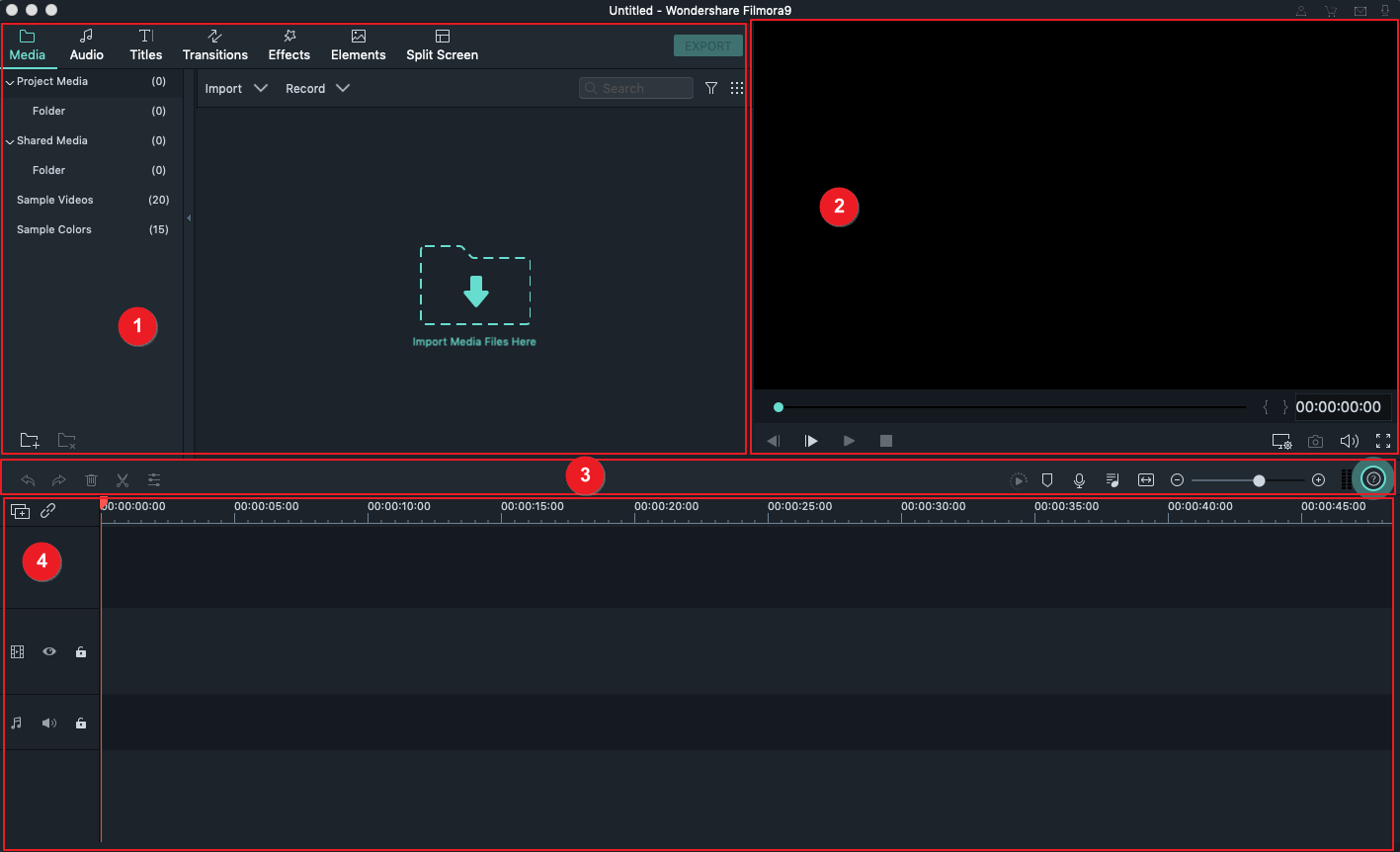
2. Enhance your video instantly in Mac
Besides all common editing tools like crop, rotate, trim, split, add voiceover and background music, Ezivd for Mac also enables you to touch up videos by an extensive list of fabulous video edits.
For example, you can apply Mosaic to hide personal or copyrighted info, create a close-up to stand out from the crowd, adjust the playing speed like 2x faster to make fun. Let alone picking up your favorite effects from rich transitions, visual filters, intros/credits, texts, sounds, and more.
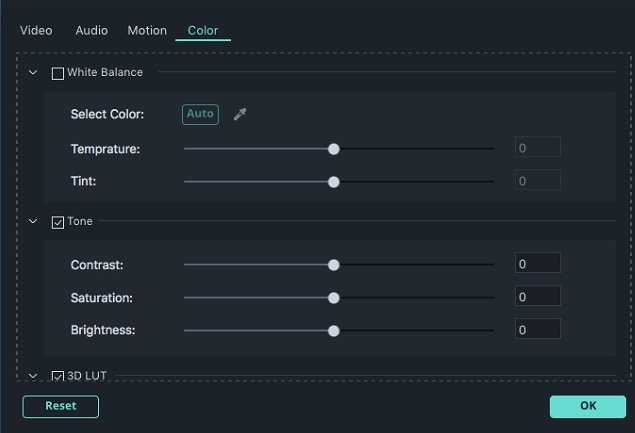
3. Share the finished video with the worldwide
When you finish video editing, there are a variety of options available to export your creation. Like Ezvid, you can easily upload your masterpiece to YouTube directly from this Ezvid alternative, as well as a message to Facebook and Twitter. Or save it on the computer in all SD and HD formats like AVI, WMV, MOV, MKV, and so on.
More often, you’ll choose to play on portable devices like iPad, iPhone, Samsung Galaxy SIII, etc. Even burning DVD or DVD folders is included in this software for permanent preservation.


Liza Brown
Liza Brown is a writer and a lover of all things video.
Follow @Liza Brown
Liza Brown
Mar 27, 2024• Proven solutions
Ezvid is a simple and fast video maker for Windows users to create and share videos directly to YouTube. Designed for both professional and amateur users, it can help you create amazing slideshows and home movies in minutes instead of hours.
If you get used to Ezvid, and just moved to a Mac, you might wonder if Ezvid also comes with a Mac version. Unfortunately, Ezvid does not support Mac and as a result, you have to find a video program that is similar to Ezivd. If this is your case, give Wondershare Filmora (originally Wondershare Video Editor) for Mac a try. It can function as a powerful Ezivd for Mac by users of all ages.
Check the video tutorial about how to edit videos on Mac first.
1. Intuitive interface and precise video editing
Wondershare Filmora is a photo video maker for Mac features a stylish interface and handy editing tools.
It provides a media browser for you to import all your local video, audio, or still images conveniently. Only by drag-and-drop, you can arrange and organize the videos for easy editing.
All video editing is based on Timeline, which lets you edit the video & audio comfortably. Also, it provides a side-by-side previewing window. What you see is what you get.

2. Enhance your video instantly in Mac
Besides all common editing tools like crop, rotate, trim, split, add voiceover and background music, Ezivd for Mac also enables you to touch up videos by an extensive list of fabulous video edits.
For example, you can apply Mosaic to hide personal or copyrighted info, create a close-up to stand out from the crowd, adjust the playing speed like 2x faster to make fun. Let alone picking up your favorite effects from rich transitions, visual filters, intros/credits, texts, sounds, and more.

3. Share the finished video with the worldwide
When you finish video editing, there are a variety of options available to export your creation. Like Ezvid, you can easily upload your masterpiece to YouTube directly from this Ezvid alternative, as well as a message to Facebook and Twitter. Or save it on the computer in all SD and HD formats like AVI, WMV, MOV, MKV, and so on.
More often, you’ll choose to play on portable devices like iPad, iPhone, Samsung Galaxy SIII, etc. Even burning DVD or DVD folders is included in this software for permanent preservation.


Liza Brown
Liza Brown is a writer and a lover of all things video.
Follow @Liza Brown
Liza Brown
Mar 27, 2024• Proven solutions
Ezvid is a simple and fast video maker for Windows users to create and share videos directly to YouTube. Designed for both professional and amateur users, it can help you create amazing slideshows and home movies in minutes instead of hours.
If you get used to Ezvid, and just moved to a Mac, you might wonder if Ezvid also comes with a Mac version. Unfortunately, Ezvid does not support Mac and as a result, you have to find a video program that is similar to Ezivd. If this is your case, give Wondershare Filmora (originally Wondershare Video Editor) for Mac a try. It can function as a powerful Ezivd for Mac by users of all ages.
Check the video tutorial about how to edit videos on Mac first.
1. Intuitive interface and precise video editing
Wondershare Filmora is a photo video maker for Mac features a stylish interface and handy editing tools.
It provides a media browser for you to import all your local video, audio, or still images conveniently. Only by drag-and-drop, you can arrange and organize the videos for easy editing.
All video editing is based on Timeline, which lets you edit the video & audio comfortably. Also, it provides a side-by-side previewing window. What you see is what you get.

2. Enhance your video instantly in Mac
Besides all common editing tools like crop, rotate, trim, split, add voiceover and background music, Ezivd for Mac also enables you to touch up videos by an extensive list of fabulous video edits.
For example, you can apply Mosaic to hide personal or copyrighted info, create a close-up to stand out from the crowd, adjust the playing speed like 2x faster to make fun. Let alone picking up your favorite effects from rich transitions, visual filters, intros/credits, texts, sounds, and more.

3. Share the finished video with the worldwide
When you finish video editing, there are a variety of options available to export your creation. Like Ezvid, you can easily upload your masterpiece to YouTube directly from this Ezvid alternative, as well as a message to Facebook and Twitter. Or save it on the computer in all SD and HD formats like AVI, WMV, MOV, MKV, and so on.
More often, you’ll choose to play on portable devices like iPad, iPhone, Samsung Galaxy SIII, etc. Even burning DVD or DVD folders is included in this software for permanent preservation.


Liza Brown
Liza Brown is a writer and a lover of all things video.
Follow @Liza Brown
Liza Brown
Mar 27, 2024• Proven solutions
Ezvid is a simple and fast video maker for Windows users to create and share videos directly to YouTube. Designed for both professional and amateur users, it can help you create amazing slideshows and home movies in minutes instead of hours.
If you get used to Ezvid, and just moved to a Mac, you might wonder if Ezvid also comes with a Mac version. Unfortunately, Ezvid does not support Mac and as a result, you have to find a video program that is similar to Ezivd. If this is your case, give Wondershare Filmora (originally Wondershare Video Editor) for Mac a try. It can function as a powerful Ezivd for Mac by users of all ages.
Check the video tutorial about how to edit videos on Mac first.
1. Intuitive interface and precise video editing
Wondershare Filmora is a photo video maker for Mac features a stylish interface and handy editing tools.
It provides a media browser for you to import all your local video, audio, or still images conveniently. Only by drag-and-drop, you can arrange and organize the videos for easy editing.
All video editing is based on Timeline, which lets you edit the video & audio comfortably. Also, it provides a side-by-side previewing window. What you see is what you get.

2. Enhance your video instantly in Mac
Besides all common editing tools like crop, rotate, trim, split, add voiceover and background music, Ezivd for Mac also enables you to touch up videos by an extensive list of fabulous video edits.
For example, you can apply Mosaic to hide personal or copyrighted info, create a close-up to stand out from the crowd, adjust the playing speed like 2x faster to make fun. Let alone picking up your favorite effects from rich transitions, visual filters, intros/credits, texts, sounds, and more.

3. Share the finished video with the worldwide
When you finish video editing, there are a variety of options available to export your creation. Like Ezvid, you can easily upload your masterpiece to YouTube directly from this Ezvid alternative, as well as a message to Facebook and Twitter. Or save it on the computer in all SD and HD formats like AVI, WMV, MOV, MKV, and so on.
More often, you’ll choose to play on portable devices like iPad, iPhone, Samsung Galaxy SIII, etc. Even burning DVD or DVD folders is included in this software for permanent preservation.


Liza Brown
Liza Brown is a writer and a lover of all things video.
Follow @Liza Brown
The Best of the Rest: 10+ Windows Movie Maker Alternatives
Windows Movie Maker has been a cornerstone tool for video editors for quite a while. There are a lot of amateurs who’ve made use of the free program and have done wonders with it. As it is discontinued, many Windows Movie Maker alternatives claim to offer ‘just the right video editing tool for you,’ few can live up to their promises—and most are very expensive.
We have ten other programs that can be used to create videos that include everything from Apple iMovie to other basic alternatives.
So whether you’re a beginner who wants to learn how to make a movie, a pro looking for an excellent alternative to Windows Movie Maker, or someone who wants to make a simple slide presentation or online video, you’re bound to find a video creation program here.
- Wondershare Filmora
- Avidemux Video Editor
- VirtualDub
- Sony Vegas Movie Studio
- WeVideo
- Lightworks
- ShotCut
- OpenShot
- Movavi Video Editor Plus
- VSDC Free Video Editor
- VideoPad Video Editor
- HitFilm
- Magix Movie Studio
- How To Edit a Video With a Windows Movie Maker Alternative
- Hot FAQs on Windows Movie Maker Alternatives
Part 1: Top 3 Picks for Windows Movie Maker Alternatives
The world’s best video editing software is about to change. We look at three of the most popular and valuable alternatives to Windows Movie Maker.
You will need to consider these alternatives to ensure they meet your expectations and needs.
1. Wondershare Filmora - Best Overall

Filmora is the best Windows Movie Maker Alternative designed according to your convenience.
Ratings: 4.4 Stars out 5
Starting from $49.99
2. Magix Movie Studio - Best for Collages

This alternative offers a variety of tools and plugins for anyone who wants to create professional-level videos in under a minute.
Download on Windows
Ratings: 4 stars out of 5
30-day free trials, then starts from $69.99 all the way to $129
3. Avidemux Video Editor - Best Open-Source Editor

An open-source editor that supports a wide range of formats is free! Avidemux has an interface similar to Windows Movie Maker, which makes it a perfect alternative.
Download on Windows
Ratings: 4.0 stars out of 5
Free Trial
Part 2: Ultimate Overview on 13 Best Alternatives to Windows Movie Maker
We live in visual culture, and we constantly see, capture, upload, and share videos on our smartphones, tablets, and laptops. So, it is only natural that more people seek ways to edit their videos. Windows Movie Maker was one of the most popular video editing apps. So it’s time to dig into the best Windows Movie Maker alternatives, which are arguably better and feature-rich.
| Software | OS | Media Resources | AI editing | Easy to Use | Free Trial |
|---|---|---|---|---|---|
| Wondershare Filmora | WindowsMacMobile | Yes | Yes | Yes | Yes |
| Avidemux | WindowsOS XLinuxBSD | Yes | No | Yes | Yes |
| Virtual Dub | Windows | No | No | Yes | Yes |
| Vegas Movie Studio | Windows | Yes | Yes | No | No |
| WeVideo | Online | Yes | No | Yes | Yes |
| Lightworks | LinuxOS X Windows | Yes | Yes | No | No |
| ShotCut | WindowsMacLinuxBSD | Yes | No | No | Yes |
| OpenShot | WindowsMacLinuxChrome OS | Yes | No | Yes | Yes |
| Movavi Plus | WindowsMac | Yes | No | Yes | Yes |
| VSDC | Windows | Yes | No | Yes | Yes |
| VideoPad | WindowsMaciPad/iPhone | Yes | No | Yes | Yes |
| HitFilm | WindowsMac | Yes | Yes | Yes | Yes |
| Magix Movie Studio | Windows | Yes | Yes | No | Yes |
Part 3: 13 Best Windows Movie Maker Alternatives for Windows
As we all know, Windows Movie Maker is the most used and trusted tool for creating videos in Windows. With its unique features and user-friendly interface, people often use this software to develop short and entertaining videos.
However, the fact is that Windows Movie Maker is not the current best video editing software for creating complex video projects. For this reason, we compiled a list of the 12 best alternatives to offer you a better option for Windows Movie Maker.
1. Wondershare Filmora
Filmora 11 is a powerful, easy-to-use video editor specially designed to streamline your workflow and save you hours weekly. It supports everything from Windows, Mac, and IOS to Android. The latest update to the flagship app includes several key enhancements that result in a much more efficient video creation workflow and one that’s easier to use than its rivals.
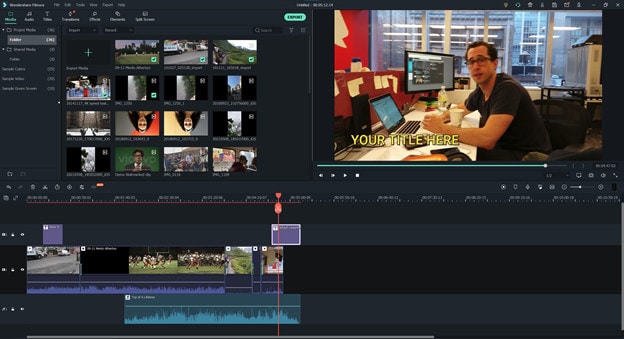
Key features
- Preset Templates
- Instant Mode
- Motion Tracking
- AI Editing Effects
- Auto Synchronization
- Plug-ins
Price
- Annual Plan: $49.99
- Perpetual Plan: $79.99
Pros
- Seamless interface for beginners
- Great customer support
- Plenty of effects and preset templates
- 4K video output options
Cons
- Rendering requires too much time
- The mobile app requires separate subscription
Supported OS: Windows , Mac , iOS , Android , iPad
G2 Ratings: 4.4 stars out of 5
Summary
Filmora’s intuitive interface allows experienced and brand-new users to create incredible videos with flawless special effects. Its high ratings and multiple supported formats make it quite popular among users.
2. Avidemux Video Editor
If you are a beginner and want to use a free, open-source software program for basic video editing, then Avidemux is a good choice. The interface is not as fancy as it could be, but there are some presets that’ll save you a lot of time. Avidemux is a cross-platform video editor that allows you to create custom videos, but it doesn’t feature the ability to share the edited footage to social media directly,
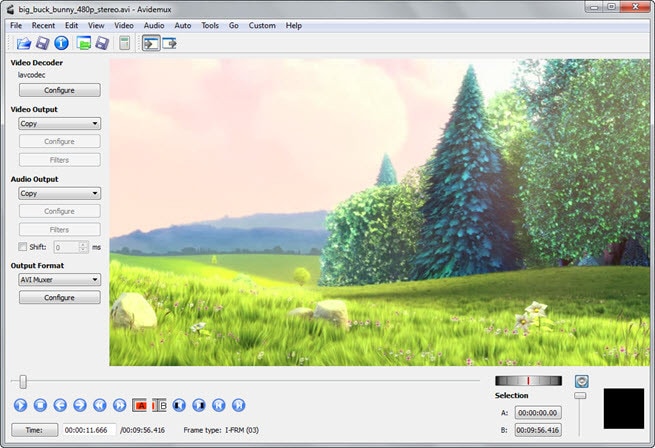
Key features
- Video and Audio Filters
- Support Popular Formats
- Convert Video For Archiving or Publishing
Price: Free
Pros
- It can convert Video To A Smaller Size
- Easy cut, trim, split video
Cons
- Out-dated UI
- Lacks sharing option
Supported OS: Windows , OS X , Linux , BSD
Uptodown Ratings: 4.0 stars out of 5
Summary
An open-source video editor that supports most formats. Due to its obsolete UI and lack of sharing features, Avidemux has average ratings.
3. VirtualDub
This open-source software is user-friendly and allows users with little experience to navigate the software without much trouble. It supports 3rd party apps and also offers batch-processing, which means working on multiple videos simultaneously makes it possible.
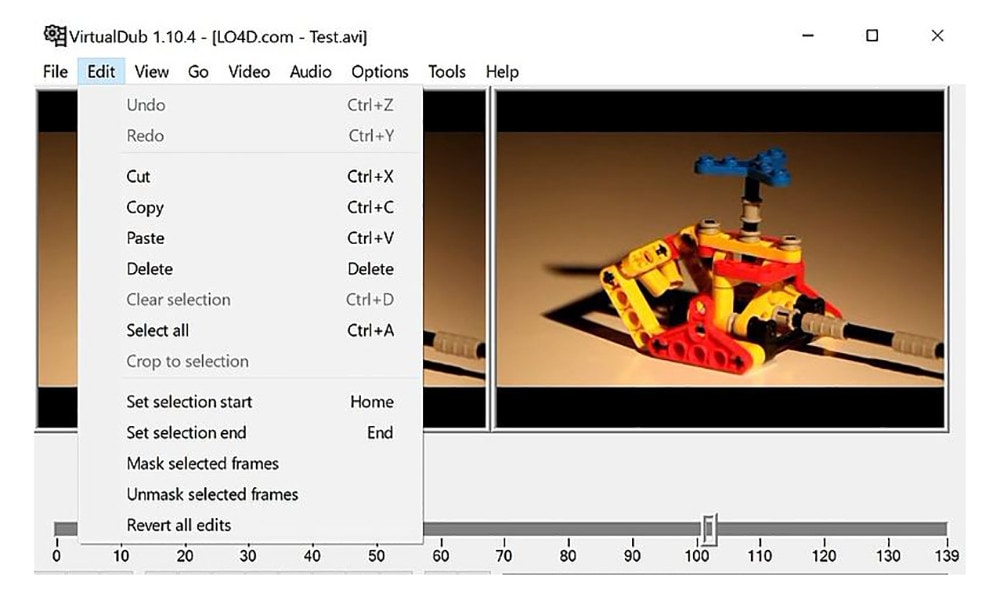
Key features
- Integrated volume and histogram meter
- Optimized disk
- Noise reduction
- Fractional frame rates
Price: Free
Pros
- Clean interface, easy to use
- Keyboard and mouse shortcuts for faster operation
- Free to use
Cons
- Not suitable for 4K editing
- Lack learning material
- Obsolete Interface
Supported OS: Windows
Compare Camp Ratings: 4.0 stars out of 5
Summary
Virtual Dub supports multitasking, and its features are pretty helpful. However, it lacks 4k editing and a friendly interface. Overall Virtual Dub is a good choice.
4. Sony Vegas Movie Studio
This video editing software makes it easy to create professional-looking videos in minimum time and effort. Vegas Movie Studio software is best for video editing professionals who have been doing it for some time and are looking for something a little more sophisticated than free alternatives. Not only does it has a high retail price, but its internal elements can be too complex for those just beginning.
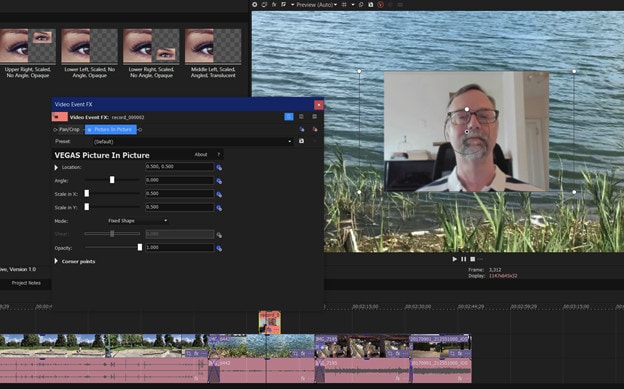
Key features
- Color correction
- HDV and AVCHD-editing
- DV batch capture
- Wide variety of file formats and codecs
Price: Starting from $7.99 USD per month
Pros
- Customizable interface
- Multicam editing
- Lots of effects and transitions, with plug-in capability
- Good slow motion and warp flow transition tools
Cons
- Less intuitive interface than competitors
- Import from camcorder not ideal
- Some tools are complex
Supported OS: Windows
G2 Ratings: 4.4 out of 5
Summary
Vegas Movie Studio is the choice of professionals. It does all the work without taking up a lot of resources, and like most programs, there is a learning curve. It’s not always intuitive for beginners, but its professional and powerful features score decent in most reviews.
5. WeVideo
This cloud-based application is a simple-to-use video editing and sharing suite. WeVideo is a full-featured video editing application that uses JumpStart technology to create amazing videos. It’s an innovative app that offers a seamless editing experience as it supports multiple formats of video, images, audio, and graphics.
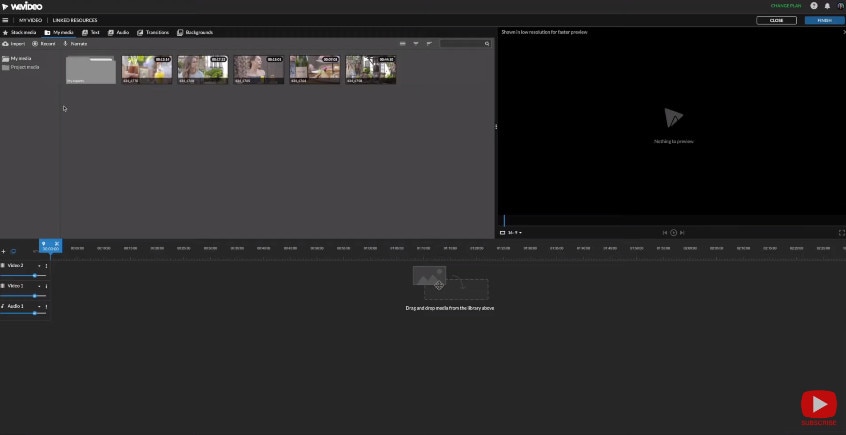
Key features
- WeVideo JumpStart
- Cloud storage
- Built-in graphics
- Customizable environment
- Advanced text editing
- Multi-track editing and storyboard
Price
- Free trial
- Power Plan: $9.99/month
- Unlimited Plan: $15.99/month
- Professional Plan: $39.99/month
- Business Plan: $73.99/month
Pros
- Constantly improving features
- Ease of use
- Storage is cloud-based
Cons
- Old fashion transition
- Leaves a watermark on free trial
Supported OS: Online
Trustpilot Ratings: 4 stars out of 5
Summary
WeVideo is a straightforward yet robust video editor. It offers a variety of features and supports multiple formats, plus its comprehensive pricing plan makes it useful for everyone.
6. Lightworks
Lightworks is the most powerful video editor in its class and an excellent tool for professionals who want to make amazing videos quickly. Lightworks is very fast and straightforward to use, and it has some great features you won’t find in any other video editor. It is available on all popular OS.
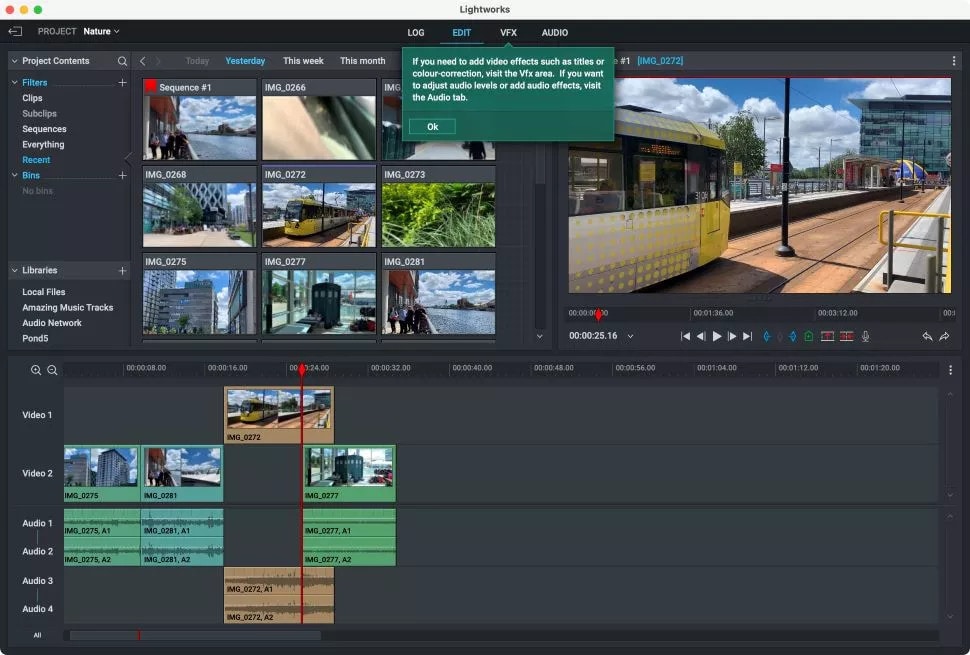
Key features
- Audio and Video Effect Plugin Support
- Cloud Connected
- Motion Graphics
- Advanced Metadata
- Proxy Workflows
- Apple ProRes decoding
Price
- Monthly Plan: $9.99/user
- Yearly Plan: $9.99/user
- Perpetual: $154.99
Pros
- High-resolution timeline rendering
- It has social media export templates
- Interfaces for multiple OS are consistent
- Instant autosave
Cons
- Commands are not always intuitive
- A bit pricey as compared to its competitors
Supported OS: Windows , Mac , Linux
Techradar Pro Ratings: 4 stars out of 5
Summary
Lightworks is not any other video editing tool available on the market of video editing tools. This video editing tool provides amateurs with the most sophisticated features in an optimized platform. Its scores are the highest on almost every review site.
7. ShotCut
Shotcut is a multiplatform video editor that lets you work with various formats for audio, video, image files, etc. This video editor makes it easy to mix and match the resolution and frame rates in a video file. All the changes you make in the editor can be undone and redone often. Shotcut is the best choice for video editing, without question.

Key features
- Webcam capture
- Audio scopes and filters
- Deinterlacing
- Eyedropper tool
- Video wipe transitions
- Keyframes for filter parameters
Price: Free
Pros
- Support for 4K resolutions
- Free
Cons
- Less intuitive than commercial apps
- Lacks built-in sharing to popular sites
Supported OS: Windows , Mac , Linux
GetApp Ratings: 4.5 out of 5 stars
Summary
Shotcut is an open-source video editor for creative professionals and is available on mac, Windows, and Linux. The free version of Shotcut has many excellent features, but it doesn’t have the slick interface or advanced techniques of the top paid editors.
8. OpenShot
An award-winning open-source video editor that creates stunning videos. OpenShot is a fast, easy-to-use, and surprisingly powerful video editor. OpenShot Video Editor allows you to work with many different types of tracks so that your edits will seem natural. OpenShot Video Editor allows you to add your custom animations or titles. The options are endless, so it all depends on your time and interest. It is available in more than 70 languages, making it ideal for all types of users.
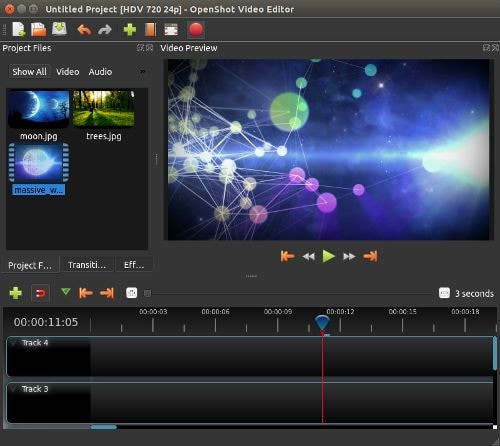
Key features
- 3D animations
- Animation and keyframes
- Multiple languages and formats
- Cross-platform
- Video-effects
Price: Free
Pros
- It is a non-linear editor with infinite tracks
- 100% free without watermark
- Frequent updates
Cons
- Obsolete interface
- Unstable performance
- Lacks some editing features
Supported OS: Window , Mac , Linux , Chrome OS
Getapp Ratings: 4.2 stars out of 5
Summary
Another open-source video-editor in the list is named OpenShot. It’s a multi-lingual and multi-supported app with unique features. Despite its unstable performance, OpenShot is still an ideal choice for many users.
9. Movavi Video Editor Plus
Movavi Video Editor Plus is the perfect tool to bring your creative ideas to life. It has special effects, ready-made intros, and keyframe animation. Using chroma keying, you can change the background of your video clips to any color or pattern that suits your need. Movavi has now redesigned its user interface to make it easy to use.
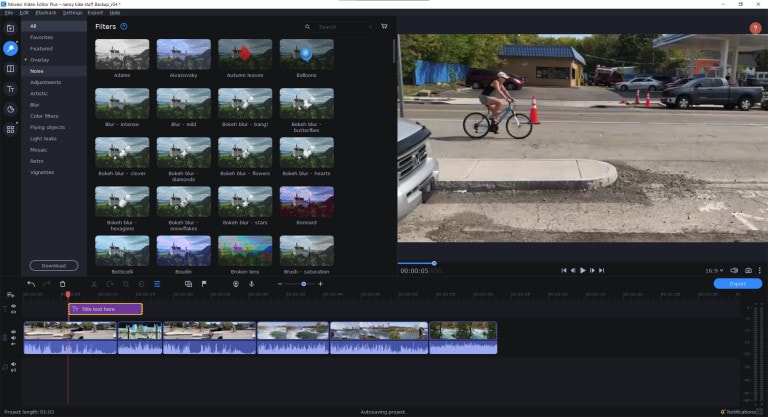
Key features
- Effects and transitions
- Built-in media pack
- Fast processing of 4K videos
- Keyframe animation
- Automatic video creation
- Cutting, trimming, joining
Price
- Free version: 7 days
- Video Editor Plus 1 year /1 PC: $49.95
- Video Editor Plus Lifetime /1 PC: $69.95
- Video Suite Lifetime /1 PC: $89.95
Pros
- Easy-to-understand user interface
- Transitions with sound
- Motion tracking and picture-in-picture tools
- Chroma-key capability
- Quick movie-creation tool
Cons
- Lacks advanced trim modes
- Slow rendering
PCMag Ratings: 4.0 stars out of 5
Summary
If you want to edit your videos with a minimal learning curve, try Movavi. You get PiP, chroma-keying, titling, basic keying, and motion tracking. The program is simple to use but doesn’t have all the features and stands four stars.
10. VSDC Free Video Editor
VSDC Free Video Editor is an online tool that lets you edit audio and video files to make your creations like movies, YouTube tutorial videos, and more. The audio and video files supported are extensive, and the software includes a codec manager. The Pro version isn’t necessary if you’re using the free edition of the software; it’s more than enough to get the job done.
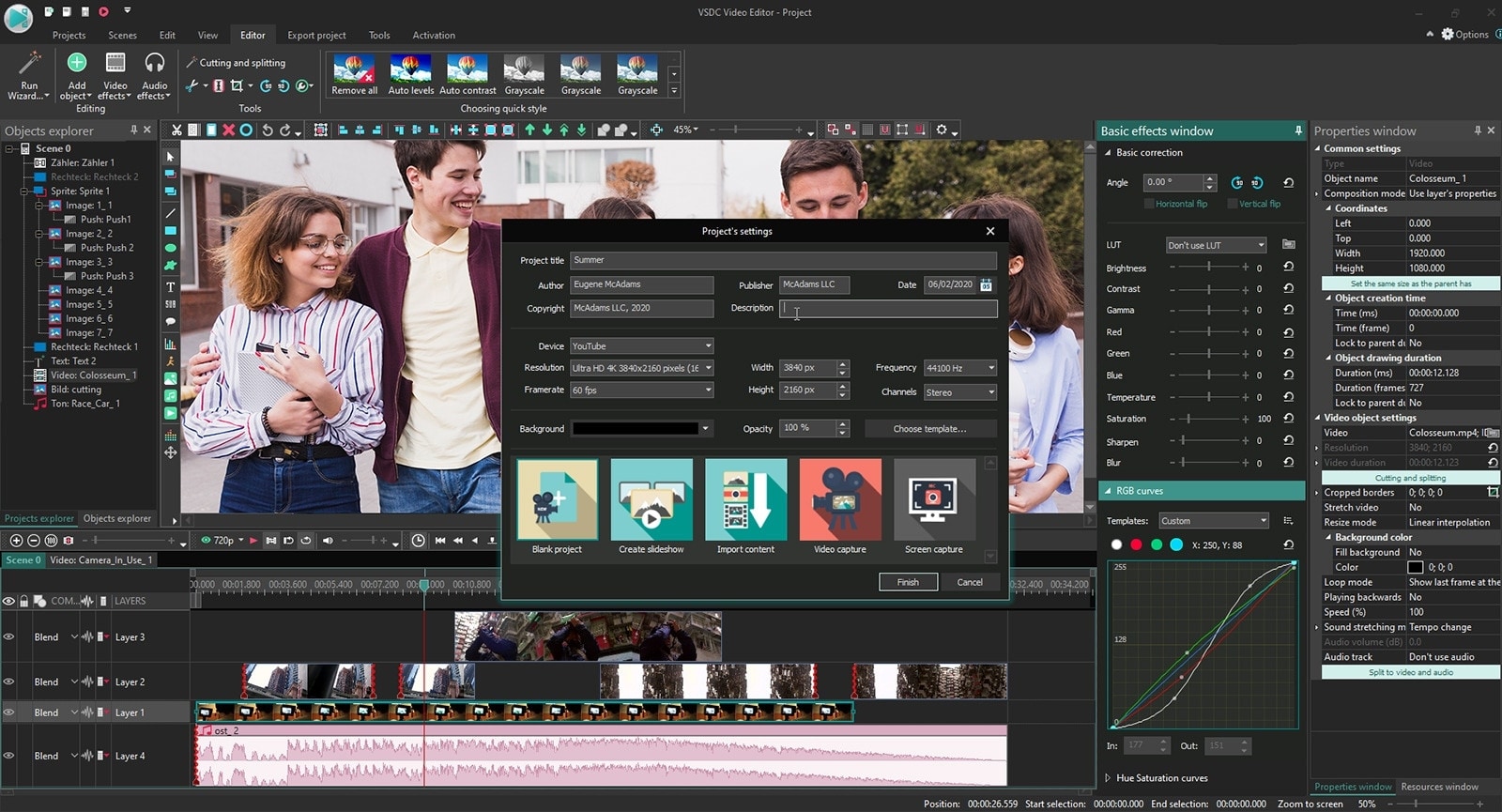
Key features
- Dark theme
- Subpixel Accuracy
- Powerful Chroma Key tool
- Trendy video effects, filters, and transitions
- Color Blending And Filters
- Built-In DVD Burning Tool
Price: Free
Pros
- Non-linear
- Video effects library
- Video stabilization
- Masking
Cons
- Outdated interface
- Lack keyboard shortcuts
- Only available on Windows
Supported OS: Windows
Capterra Ratings: 4.5 stars out 5
Summary
VSDC is a non-linear editor with extensive format support. It includes all the essential features an editor requires but with an obsolete UI. It is also ideal for many who need a powerful yet free video editor.
11. VideoPad Video Editor
VideoPad is a free video editor that can create stunning videos and perform basic editing tasks. A good video editor can help you to create videos for different social media platforms. You can make your videos look professional and polished with a few clicks and some simple editing skills. There’s nothing particularly exciting or advanced about this app; it’s simple enough for anyone new to video editing or even for seasoned editors. But the simple and easy-to-use interface makes the entire process very exciting.
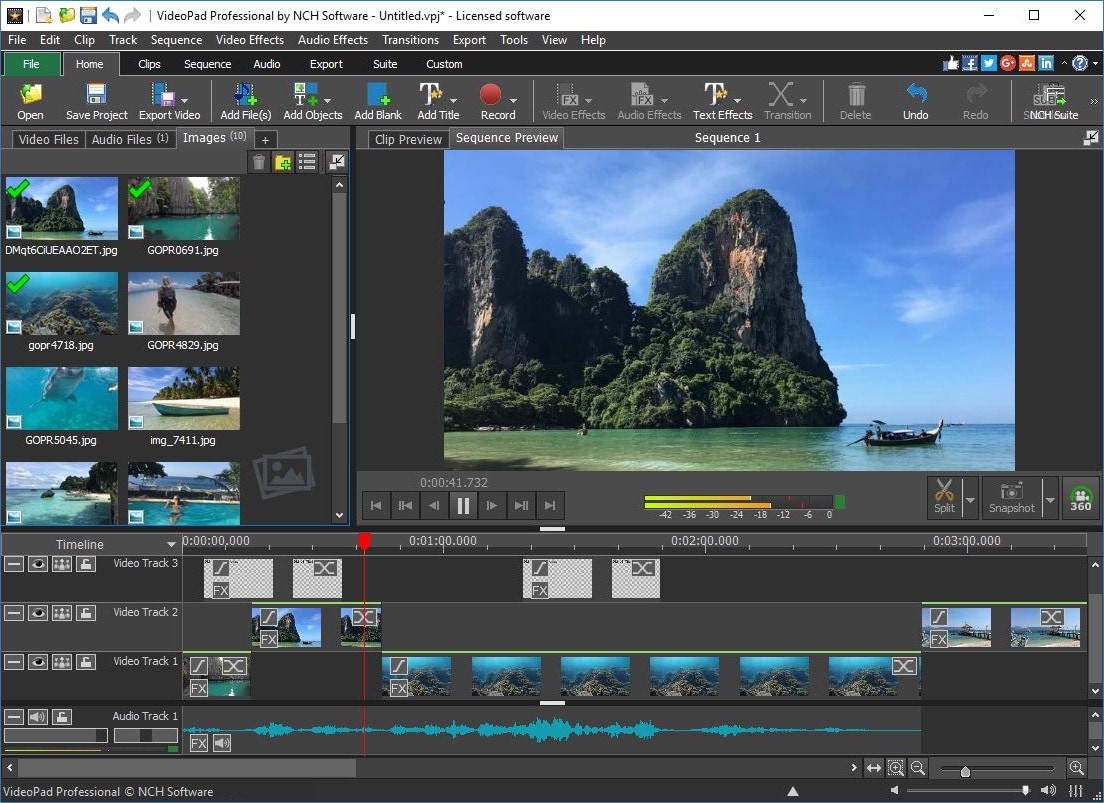
Key features
- Text snippets
- Range of transitional effects
- Plug-ins Library
- Burn finished videos to Blu-Ray, DVD, etc.
- Color correction and light balance.
Price: Free
Pros
- Simple and clean interface
- Supports multiple file formats
- Includes video effects
- Lightweight on system resources
Cons
- Lack of advanced features
Supported OS: Windows , Mac , iPad/iPhone
Tom’s guide Ratings: 3.5 stars out of 5
Summary
Video pad is a free video editor designed for beginners that is lightweight and simple. VideoPad is also great for creating quick videos for social media purposes like Youtube and Facebook. The software has a high rating, as shown above, and it’s available on Windows.
12. HitFilm
HitFilm is a helpful video editing software that makes editing easier for users. In addition to basic features, the program also provides advanced-level functions that make edited videos pop. Hitfilm Express Download has more than 400 features to help casual video editors save time. Features like: visual effects, cinematic elements, and compositing tools preset help unleash your creativity.
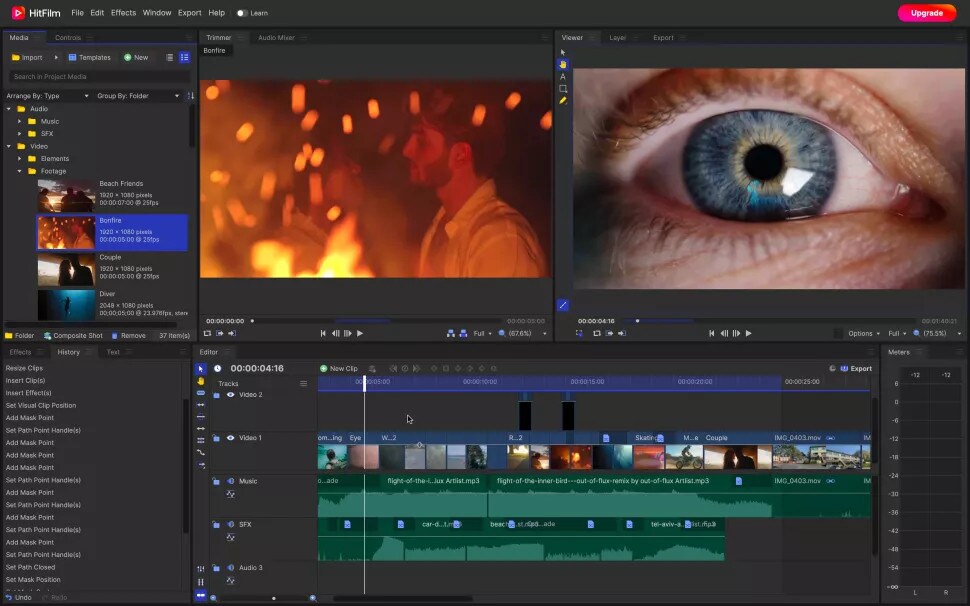
Key features
- Color Grading and correction
- Smart search
- Commentator recorder
- Lightning and lens flares
- 3D camera tracker
Price
- Free trial
- Creator: $7.50
- Pro: $12.50
- Enterprise: Custom pricing
Pros
- Intuitive interface
- It offers free tutorials and masterclasses
- Works on both Windows and Mac
Cons
- It requires heavy system requirements
TechRadar Ratings: 4.5 stars out of 5
Summary
HitFilm Express 15 is a powerful free video editing program that enables you to create high-quality videos in minutes with an intuitive interface. It offers advanced editing features such as advanced video trimming, 3D editing, and more.
13. Magix Movie Studio
Magix is the world’s leading professional audiovisual media software, with Sequoia being its industry-standard audio editing software. This movie editor is an enthusiast-level video editing software that competes with software from Adobe and CyberLink, and it even boasts support for 4K content and 360 degrees. There are many reasons to upgrade. This year’s update includes stabilization, 8K editing, motion tracking, and an in-app plug-in store.
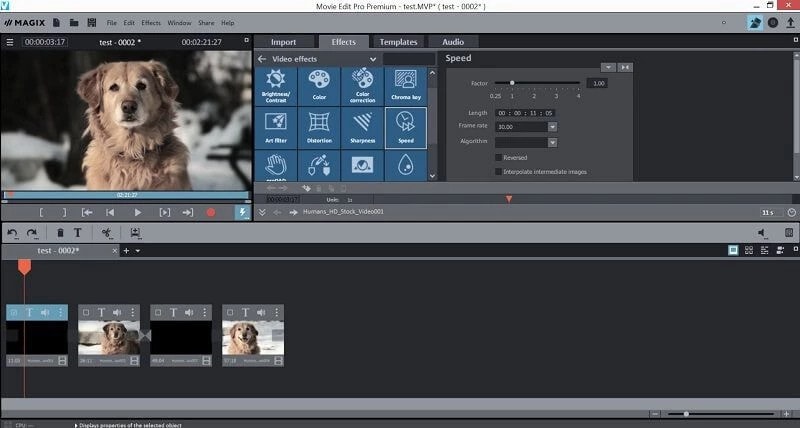
Key features
- NewBlue effects
- Fly-in animation
- New filter view
- Stabilization
- Motion tracking
- 8k support
Price
- Movie Studio 2024: $69.99 (30-day free trial)
- Movie Studio 2024 Platinum: $99.99 (30-day free trial)
- Movie Studio 2024 Suite: $129.00 (30-day free trial)
Pros
- Lots of video effects
- Responsive editing interface
- Multicam
- Trailer-like movie templates
- Solid audio editing
Cons
- Slower project rendering than others
- Lacks import and organization tools
Supported OS: Windows
PCMag Ratings: 3 stars out of 5
Summary
Magix movie studio is a powerful all-around video editing tool with many features that professional users have come to expect. It’s also relatively simple to use. But usability and performance are poor compared to other software programs like Filmora .
Part 4: How To Edit a Video With a Windows Movie Maker Alternative
Windows Movie Maker was great for editing a video, but it’s no match for some of the best video editing software. We’re talking about software capable of creating a cinematic experience in seconds, all on your computer.
When you need to edit a video with simple, quick edits, like adding a special effect or changing the background, try Filmora . Filmora is an easy-to-use application that allows you to create a movie using simple tools that don’t require additional training. You can’t beat this option if you want to create a professional-quality video for your blog or website.
Let’s dive into a quick tutorial on editing videos in Filmora:
Free Download For Win 7 or later(64-bit)
Free Download For macOS 10.14 or later
Step1 Open Wondershare Filmora on your PC or Mac
You can start a new project by clicking on ‘New Project’. And you can also change the ‘Aspect Ratio’ according to your project demand.

Step2 Import Videos
You can import your file by clicking the import tab on the upper-left side or clicking the import icon on the main window.
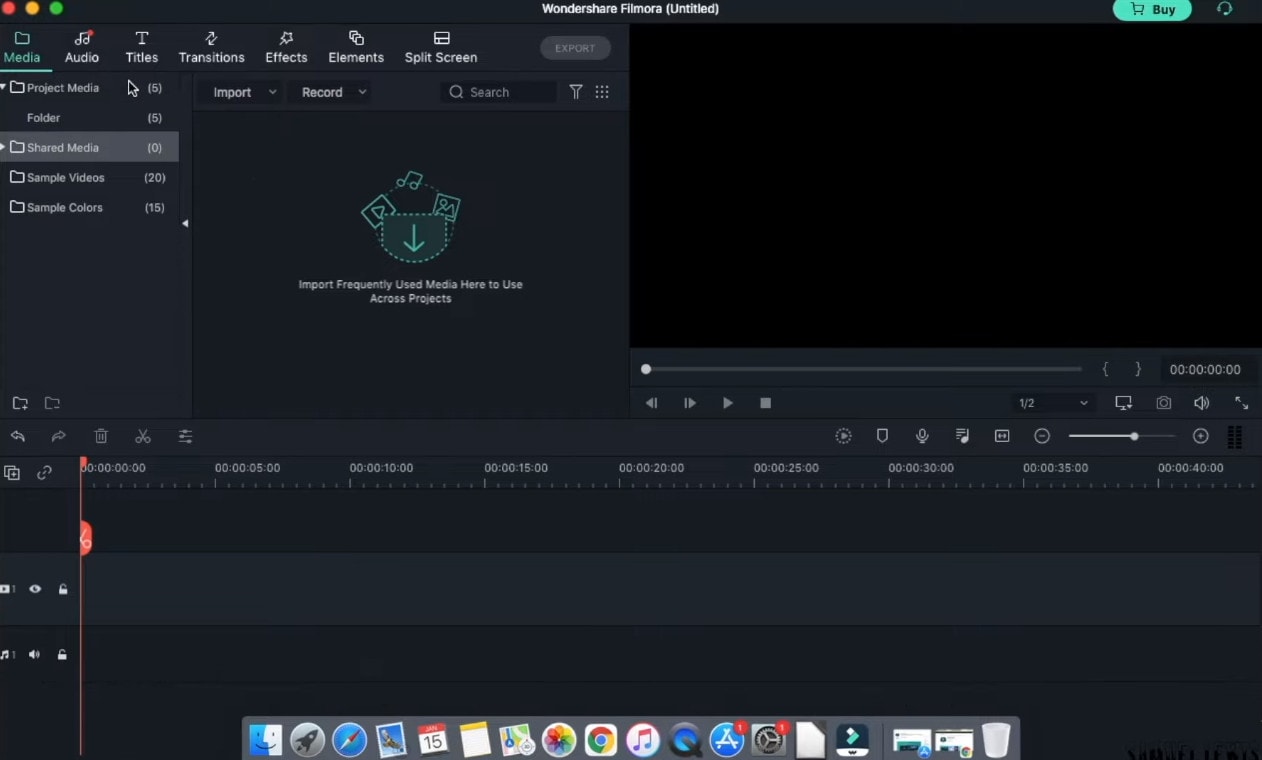
Step3 Drag and drop your footage to the timeline
After importing all the files, click and hold each individual video and drag and drop it to the timeline area according to your ideal sequence.
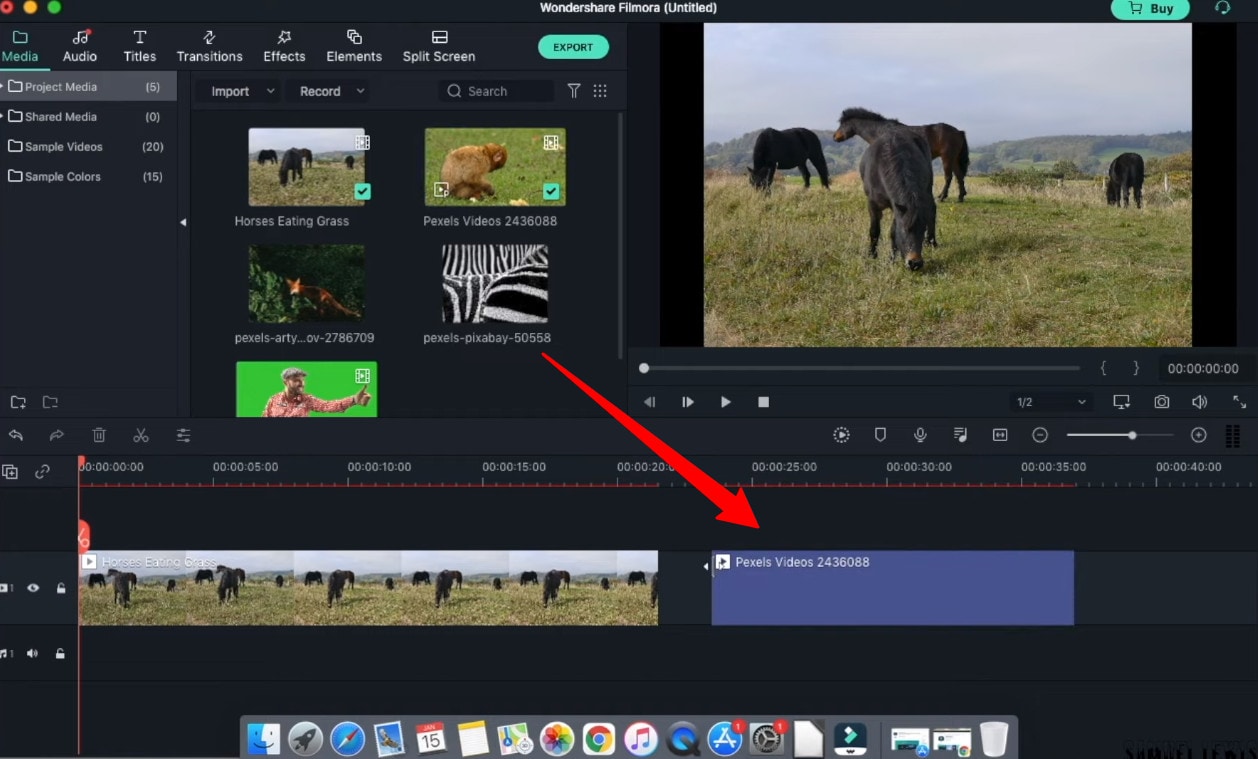
Step4 Add Audio
Go to the ‘Audio’ tab and select the audio file from the audio library. Once selected, drag and drop the audio file into the music timeline.
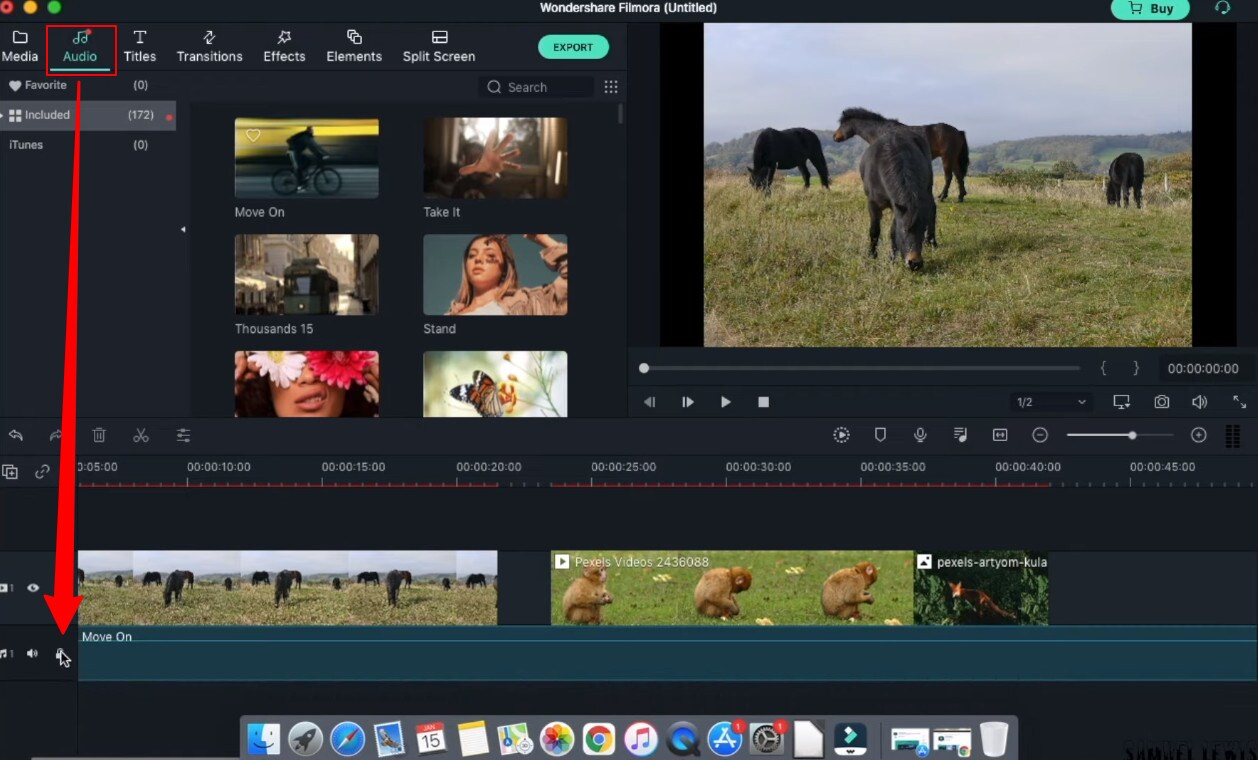
Step5 Add Titles
In your video intro, you can insert some title text. Go to the ‘Titles’ tab and select the one you like, and drag and drop it on top of the timeline. Double-click and edit the text and state your ideal statements. You can customize your text fonts and color too.
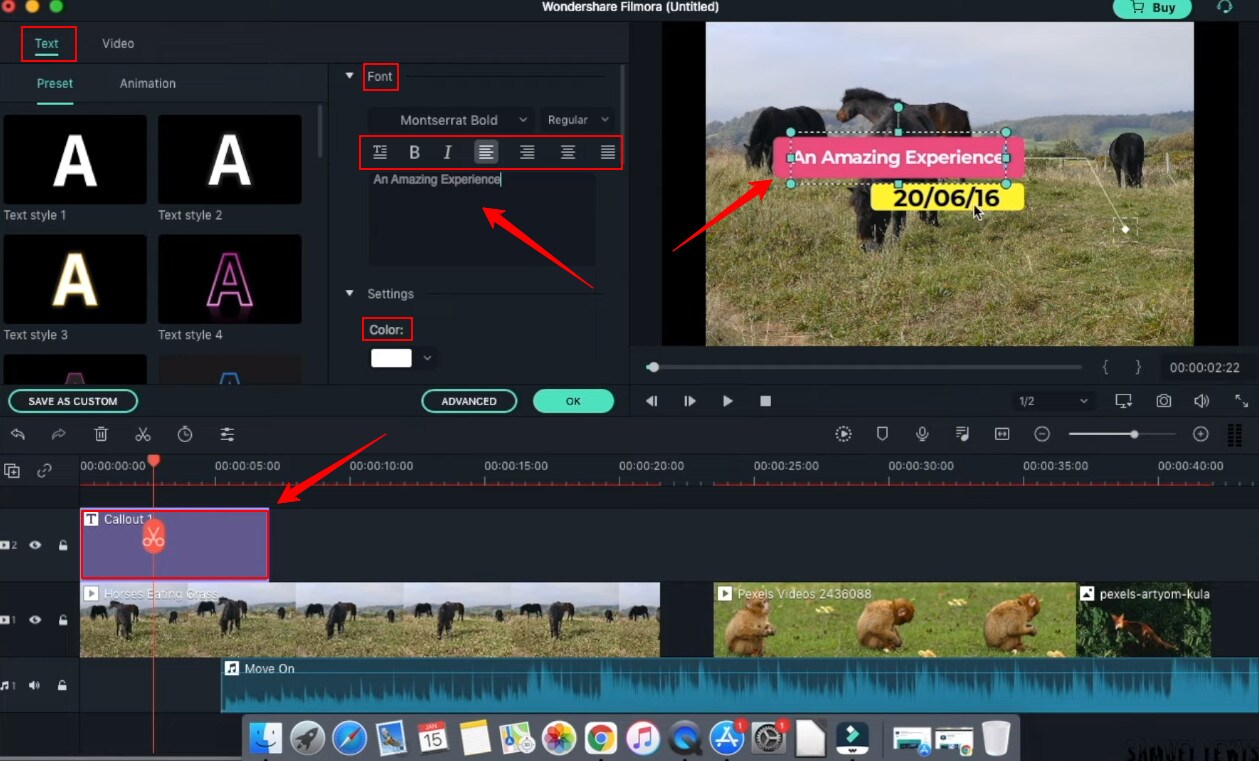
Step6 Add Transitions
You can add transition effects to ensure a smooth transition from one scene to another. The overall will get more professional look.

Step7 Add Effects
Next; you can get special effects to your video to make them more attractive and engaging to watch. Simple drag down the effect to your video and watch the effect take place in your selective scene.
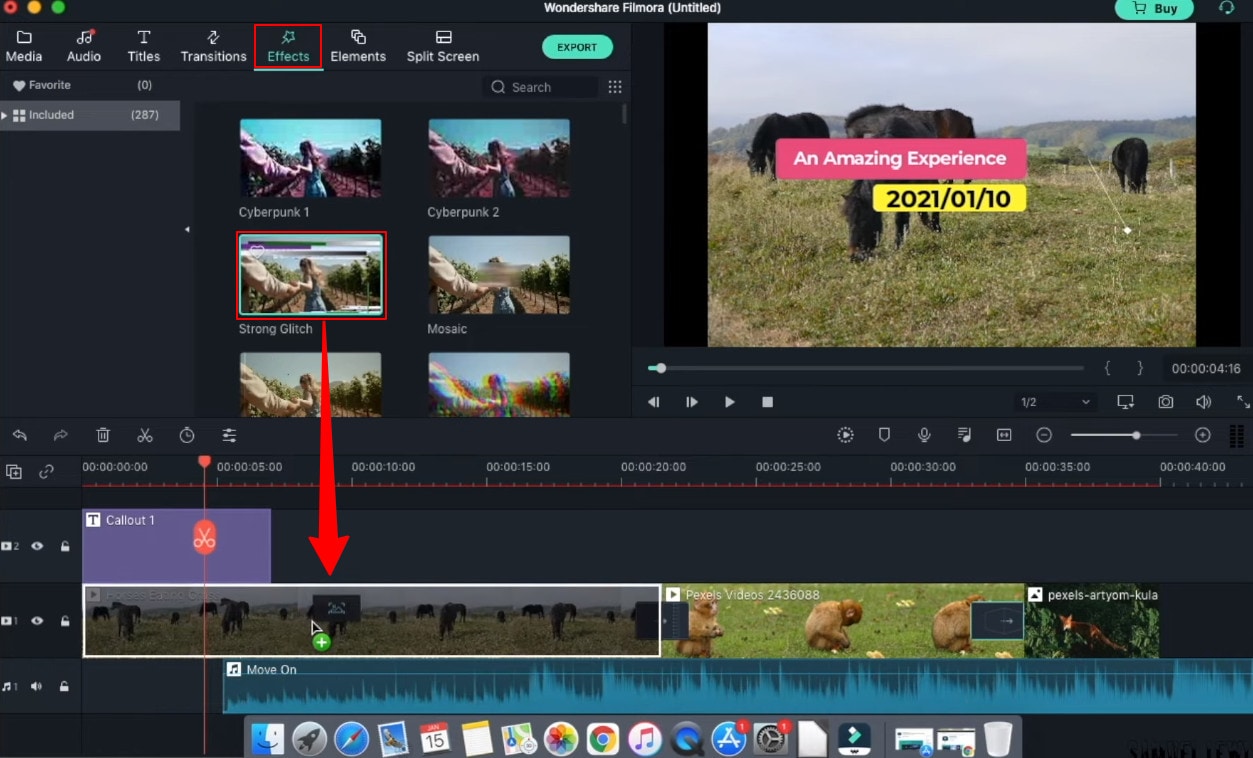
Step8 Export your work
Once all the changes have been made, hit ‘export’ from the top tab. A window will appear where you can change the settings, resolution, frame rate, bit rate, etc. Next, click the ‘export’ button down on that window, and then you can save the file in your drive.
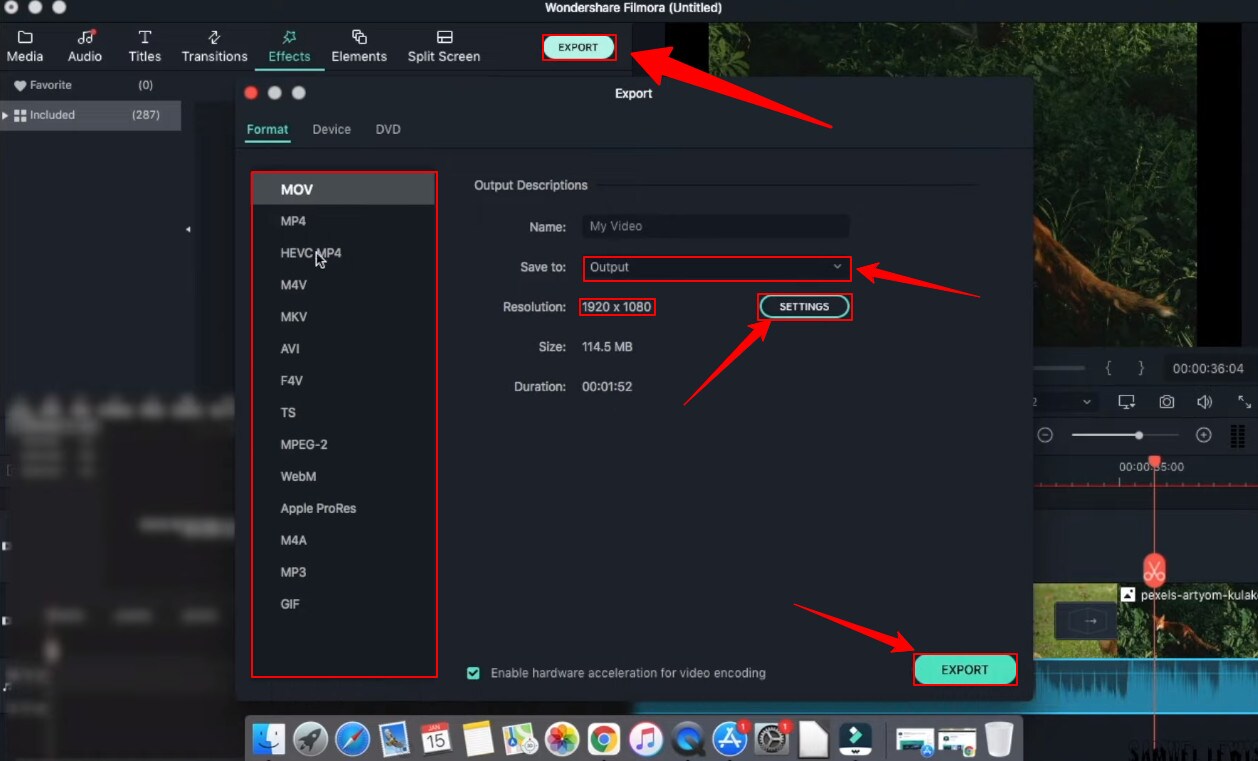
Part 5: Hot FAQs on Windows Movie Maker Alternatives
1. Why is Windows Movie Maker discontinued?
Microsoft’s video editing program, Windows Movie Maker, did not become a big hit with the public because it failed to do well on the market. Microsoft couldn’t get the support they were looking for from the program’s users. As a result, Microsoft had to cease its support of the program.
2. Is there a free version of Windows Movie Maker?
Microsoft Windows Movie maker was always accessible and pre-installed every windows product. Microsoft has discontinued support for Movie Maker and warns about free downloads of Movie Maker provided by third parties that might contain malware, viruses, or other issues.
3. What are the best free Windows Movie Maker Alternatives for Mac?
After switching to a Mac, you’ll find that the Windows Movie Maker alternatives offer much more than just a simple video editor. They provide advanced features, easy transitions, and less technical know-how to create pro-quality results. You should try using these platforms on your Mac if you have a video to edit.
- Wondershare Filmora
- Movavi
- OpenShot
Final Words
Windows Movie Maker is an excellent Windows video editor application for Windows users. But in recent years, it has become outdated due to the continuous development of new technologies. There are many alternatives for Windows Movie Maker, and here we listed some of the best ones. Most of them are free and featured packs. Each program has its unique set of features and capabilities, and each one excels in different areas. Check them out and see what you think.
Free Download For Win 7 or later(64-bit)
Free Download For macOS 10.14 or later
Part 1: Top 3 Picks for Windows Movie Maker Alternatives
The world’s best video editing software is about to change. We look at three of the most popular and valuable alternatives to Windows Movie Maker.
You will need to consider these alternatives to ensure they meet your expectations and needs.
1. Wondershare Filmora - Best Overall

Filmora is the best Windows Movie Maker Alternative designed according to your convenience.
Ratings: 4.4 Stars out 5
Starting from $49.99
2. Magix Movie Studio - Best for Collages

This alternative offers a variety of tools and plugins for anyone who wants to create professional-level videos in under a minute.
Download on Windows
Ratings: 4 stars out of 5
30-day free trials, then starts from $69.99 all the way to $129
3. Avidemux Video Editor - Best Open-Source Editor

An open-source editor that supports a wide range of formats is free! Avidemux has an interface similar to Windows Movie Maker, which makes it a perfect alternative.
Download on Windows
Ratings: 4.0 stars out of 5
Free Trial
Part 2: Ultimate Overview on 13 Best Alternatives to Windows Movie Maker
We live in visual culture, and we constantly see, capture, upload, and share videos on our smartphones, tablets, and laptops. So, it is only natural that more people seek ways to edit their videos. Windows Movie Maker was one of the most popular video editing apps. So it’s time to dig into the best Windows Movie Maker alternatives, which are arguably better and feature-rich.
| Software | OS | Media Resources | AI editing | Easy to Use | Free Trial |
|---|---|---|---|---|---|
| Wondershare Filmora | WindowsMacMobile | Yes | Yes | Yes | Yes |
| Avidemux | WindowsOS XLinuxBSD | Yes | No | Yes | Yes |
| Virtual Dub | Windows | No | No | Yes | Yes |
| Vegas Movie Studio | Windows | Yes | Yes | No | No |
| WeVideo | Online | Yes | No | Yes | Yes |
| Lightworks | LinuxOS X Windows | Yes | Yes | No | No |
| ShotCut | WindowsMacLinuxBSD | Yes | No | No | Yes |
| OpenShot | WindowsMacLinuxChrome OS | Yes | No | Yes | Yes |
| Movavi Plus | WindowsMac | Yes | No | Yes | Yes |
| VSDC | Windows | Yes | No | Yes | Yes |
| VideoPad | WindowsMaciPad/iPhone | Yes | No | Yes | Yes |
| HitFilm | WindowsMac | Yes | Yes | Yes | Yes |
| Magix Movie Studio | Windows | Yes | Yes | No | Yes |
Part 3: 13 Best Windows Movie Maker Alternatives for Windows
As we all know, Windows Movie Maker is the most used and trusted tool for creating videos in Windows. With its unique features and user-friendly interface, people often use this software to develop short and entertaining videos.
However, the fact is that Windows Movie Maker is not the current best video editing software for creating complex video projects. For this reason, we compiled a list of the 12 best alternatives to offer you a better option for Windows Movie Maker.
1. Wondershare Filmora
Filmora 11 is a powerful, easy-to-use video editor specially designed to streamline your workflow and save you hours weekly. It supports everything from Windows, Mac, and IOS to Android. The latest update to the flagship app includes several key enhancements that result in a much more efficient video creation workflow and one that’s easier to use than its rivals.

Key features
- Preset Templates
- Instant Mode
- Motion Tracking
- AI Editing Effects
- Auto Synchronization
- Plug-ins
Price
- Annual Plan: $49.99
- Perpetual Plan: $79.99
Pros
- Seamless interface for beginners
- Great customer support
- Plenty of effects and preset templates
- 4K video output options
Cons
- Rendering requires too much time
- The mobile app requires separate subscription
Supported OS: Windows , Mac , iOS , Android , iPad
G2 Ratings: 4.4 stars out of 5
Summary
Filmora’s intuitive interface allows experienced and brand-new users to create incredible videos with flawless special effects. Its high ratings and multiple supported formats make it quite popular among users.
2. Avidemux Video Editor
If you are a beginner and want to use a free, open-source software program for basic video editing, then Avidemux is a good choice. The interface is not as fancy as it could be, but there are some presets that’ll save you a lot of time. Avidemux is a cross-platform video editor that allows you to create custom videos, but it doesn’t feature the ability to share the edited footage to social media directly,

Key features
- Video and Audio Filters
- Support Popular Formats
- Convert Video For Archiving or Publishing
Price: Free
Pros
- It can convert Video To A Smaller Size
- Easy cut, trim, split video
Cons
- Out-dated UI
- Lacks sharing option
Supported OS: Windows , OS X , Linux , BSD
Uptodown Ratings: 4.0 stars out of 5
Summary
An open-source video editor that supports most formats. Due to its obsolete UI and lack of sharing features, Avidemux has average ratings.
3. VirtualDub
This open-source software is user-friendly and allows users with little experience to navigate the software without much trouble. It supports 3rd party apps and also offers batch-processing, which means working on multiple videos simultaneously makes it possible.

Key features
- Integrated volume and histogram meter
- Optimized disk
- Noise reduction
- Fractional frame rates
Price: Free
Pros
- Clean interface, easy to use
- Keyboard and mouse shortcuts for faster operation
- Free to use
Cons
- Not suitable for 4K editing
- Lack learning material
- Obsolete Interface
Supported OS: Windows
Compare Camp Ratings: 4.0 stars out of 5
Summary
Virtual Dub supports multitasking, and its features are pretty helpful. However, it lacks 4k editing and a friendly interface. Overall Virtual Dub is a good choice.
4. Sony Vegas Movie Studio
This video editing software makes it easy to create professional-looking videos in minimum time and effort. Vegas Movie Studio software is best for video editing professionals who have been doing it for some time and are looking for something a little more sophisticated than free alternatives. Not only does it has a high retail price, but its internal elements can be too complex for those just beginning.

Key features
- Color correction
- HDV and AVCHD-editing
- DV batch capture
- Wide variety of file formats and codecs
Price: Starting from $7.99 USD per month
Pros
- Customizable interface
- Multicam editing
- Lots of effects and transitions, with plug-in capability
- Good slow motion and warp flow transition tools
Cons
- Less intuitive interface than competitors
- Import from camcorder not ideal
- Some tools are complex
Supported OS: Windows
G2 Ratings: 4.4 out of 5
Summary
Vegas Movie Studio is the choice of professionals. It does all the work without taking up a lot of resources, and like most programs, there is a learning curve. It’s not always intuitive for beginners, but its professional and powerful features score decent in most reviews.
5. WeVideo
This cloud-based application is a simple-to-use video editing and sharing suite. WeVideo is a full-featured video editing application that uses JumpStart technology to create amazing videos. It’s an innovative app that offers a seamless editing experience as it supports multiple formats of video, images, audio, and graphics.

Key features
- WeVideo JumpStart
- Cloud storage
- Built-in graphics
- Customizable environment
- Advanced text editing
- Multi-track editing and storyboard
Price
- Free trial
- Power Plan: $9.99/month
- Unlimited Plan: $15.99/month
- Professional Plan: $39.99/month
- Business Plan: $73.99/month
Pros
- Constantly improving features
- Ease of use
- Storage is cloud-based
Cons
- Old fashion transition
- Leaves a watermark on free trial
Supported OS: Online
Trustpilot Ratings: 4 stars out of 5
Summary
WeVideo is a straightforward yet robust video editor. It offers a variety of features and supports multiple formats, plus its comprehensive pricing plan makes it useful for everyone.
6. Lightworks
Lightworks is the most powerful video editor in its class and an excellent tool for professionals who want to make amazing videos quickly. Lightworks is very fast and straightforward to use, and it has some great features you won’t find in any other video editor. It is available on all popular OS.

Key features
- Audio and Video Effect Plugin Support
- Cloud Connected
- Motion Graphics
- Advanced Metadata
- Proxy Workflows
- Apple ProRes decoding
Price
- Monthly Plan: $9.99/user
- Yearly Plan: $9.99/user
- Perpetual: $154.99
Pros
- High-resolution timeline rendering
- It has social media export templates
- Interfaces for multiple OS are consistent
- Instant autosave
Cons
- Commands are not always intuitive
- A bit pricey as compared to its competitors
Supported OS: Windows , Mac , Linux
Techradar Pro Ratings: 4 stars out of 5
Summary
Lightworks is not any other video editing tool available on the market of video editing tools. This video editing tool provides amateurs with the most sophisticated features in an optimized platform. Its scores are the highest on almost every review site.
7. ShotCut
Shotcut is a multiplatform video editor that lets you work with various formats for audio, video, image files, etc. This video editor makes it easy to mix and match the resolution and frame rates in a video file. All the changes you make in the editor can be undone and redone often. Shotcut is the best choice for video editing, without question.

Key features
- Webcam capture
- Audio scopes and filters
- Deinterlacing
- Eyedropper tool
- Video wipe transitions
- Keyframes for filter parameters
Price: Free
Pros
- Support for 4K resolutions
- Free
Cons
- Less intuitive than commercial apps
- Lacks built-in sharing to popular sites
Supported OS: Windows , Mac , Linux
GetApp Ratings: 4.5 out of 5 stars
Summary
Shotcut is an open-source video editor for creative professionals and is available on mac, Windows, and Linux. The free version of Shotcut has many excellent features, but it doesn’t have the slick interface or advanced techniques of the top paid editors.
8. OpenShot
An award-winning open-source video editor that creates stunning videos. OpenShot is a fast, easy-to-use, and surprisingly powerful video editor. OpenShot Video Editor allows you to work with many different types of tracks so that your edits will seem natural. OpenShot Video Editor allows you to add your custom animations or titles. The options are endless, so it all depends on your time and interest. It is available in more than 70 languages, making it ideal for all types of users.

Key features
- 3D animations
- Animation and keyframes
- Multiple languages and formats
- Cross-platform
- Video-effects
Price: Free
Pros
- It is a non-linear editor with infinite tracks
- 100% free without watermark
- Frequent updates
Cons
- Obsolete interface
- Unstable performance
- Lacks some editing features
Supported OS: Window , Mac , Linux , Chrome OS
Getapp Ratings: 4.2 stars out of 5
Summary
Another open-source video-editor in the list is named OpenShot. It’s a multi-lingual and multi-supported app with unique features. Despite its unstable performance, OpenShot is still an ideal choice for many users.
9. Movavi Video Editor Plus
Movavi Video Editor Plus is the perfect tool to bring your creative ideas to life. It has special effects, ready-made intros, and keyframe animation. Using chroma keying, you can change the background of your video clips to any color or pattern that suits your need. Movavi has now redesigned its user interface to make it easy to use.

Key features
- Effects and transitions
- Built-in media pack
- Fast processing of 4K videos
- Keyframe animation
- Automatic video creation
- Cutting, trimming, joining
Price
- Free version: 7 days
- Video Editor Plus 1 year /1 PC: $49.95
- Video Editor Plus Lifetime /1 PC: $69.95
- Video Suite Lifetime /1 PC: $89.95
Pros
- Easy-to-understand user interface
- Transitions with sound
- Motion tracking and picture-in-picture tools
- Chroma-key capability
- Quick movie-creation tool
Cons
- Lacks advanced trim modes
- Slow rendering
PCMag Ratings: 4.0 stars out of 5
Summary
If you want to edit your videos with a minimal learning curve, try Movavi. You get PiP, chroma-keying, titling, basic keying, and motion tracking. The program is simple to use but doesn’t have all the features and stands four stars.
10. VSDC Free Video Editor
VSDC Free Video Editor is an online tool that lets you edit audio and video files to make your creations like movies, YouTube tutorial videos, and more. The audio and video files supported are extensive, and the software includes a codec manager. The Pro version isn’t necessary if you’re using the free edition of the software; it’s more than enough to get the job done.

Key features
- Dark theme
- Subpixel Accuracy
- Powerful Chroma Key tool
- Trendy video effects, filters, and transitions
- Color Blending And Filters
- Built-In DVD Burning Tool
Price: Free
Pros
- Non-linear
- Video effects library
- Video stabilization
- Masking
Cons
- Outdated interface
- Lack keyboard shortcuts
- Only available on Windows
Supported OS: Windows
Capterra Ratings: 4.5 stars out 5
Summary
VSDC is a non-linear editor with extensive format support. It includes all the essential features an editor requires but with an obsolete UI. It is also ideal for many who need a powerful yet free video editor.
11. VideoPad Video Editor
VideoPad is a free video editor that can create stunning videos and perform basic editing tasks. A good video editor can help you to create videos for different social media platforms. You can make your videos look professional and polished with a few clicks and some simple editing skills. There’s nothing particularly exciting or advanced about this app; it’s simple enough for anyone new to video editing or even for seasoned editors. But the simple and easy-to-use interface makes the entire process very exciting.

Key features
- Text snippets
- Range of transitional effects
- Plug-ins Library
- Burn finished videos to Blu-Ray, DVD, etc.
- Color correction and light balance.
Price: Free
Pros
- Simple and clean interface
- Supports multiple file formats
- Includes video effects
- Lightweight on system resources
Cons
- Lack of advanced features
Supported OS: Windows , Mac , iPad/iPhone
Tom’s guide Ratings: 3.5 stars out of 5
Summary
Video pad is a free video editor designed for beginners that is lightweight and simple. VideoPad is also great for creating quick videos for social media purposes like Youtube and Facebook. The software has a high rating, as shown above, and it’s available on Windows.
12. HitFilm
HitFilm is a helpful video editing software that makes editing easier for users. In addition to basic features, the program also provides advanced-level functions that make edited videos pop. Hitfilm Express Download has more than 400 features to help casual video editors save time. Features like: visual effects, cinematic elements, and compositing tools preset help unleash your creativity.

Key features
- Color Grading and correction
- Smart search
- Commentator recorder
- Lightning and lens flares
- 3D camera tracker
Price
- Free trial
- Creator: $7.50
- Pro: $12.50
- Enterprise: Custom pricing
Pros
- Intuitive interface
- It offers free tutorials and masterclasses
- Works on both Windows and Mac
Cons
- It requires heavy system requirements
TechRadar Ratings: 4.5 stars out of 5
Summary
HitFilm Express 15 is a powerful free video editing program that enables you to create high-quality videos in minutes with an intuitive interface. It offers advanced editing features such as advanced video trimming, 3D editing, and more.
13. Magix Movie Studio
Magix is the world’s leading professional audiovisual media software, with Sequoia being its industry-standard audio editing software. This movie editor is an enthusiast-level video editing software that competes with software from Adobe and CyberLink, and it even boasts support for 4K content and 360 degrees. There are many reasons to upgrade. This year’s update includes stabilization, 8K editing, motion tracking, and an in-app plug-in store.

Key features
- NewBlue effects
- Fly-in animation
- New filter view
- Stabilization
- Motion tracking
- 8k support
Price
- Movie Studio 2024: $69.99 (30-day free trial)
- Movie Studio 2024 Platinum: $99.99 (30-day free trial)
- Movie Studio 2024 Suite: $129.00 (30-day free trial)
Pros
- Lots of video effects
- Responsive editing interface
- Multicam
- Trailer-like movie templates
- Solid audio editing
Cons
- Slower project rendering than others
- Lacks import and organization tools
Supported OS: Windows
PCMag Ratings: 3 stars out of 5
Summary
Magix movie studio is a powerful all-around video editing tool with many features that professional users have come to expect. It’s also relatively simple to use. But usability and performance are poor compared to other software programs like Filmora .
Part 4: How To Edit a Video With a Windows Movie Maker Alternative
Windows Movie Maker was great for editing a video, but it’s no match for some of the best video editing software. We’re talking about software capable of creating a cinematic experience in seconds, all on your computer.
When you need to edit a video with simple, quick edits, like adding a special effect or changing the background, try Filmora . Filmora is an easy-to-use application that allows you to create a movie using simple tools that don’t require additional training. You can’t beat this option if you want to create a professional-quality video for your blog or website.
Let’s dive into a quick tutorial on editing videos in Filmora:
Free Download For Win 7 or later(64-bit)
Free Download For macOS 10.14 or later
Step1 Open Wondershare Filmora on your PC or Mac
You can start a new project by clicking on ‘New Project’. And you can also change the ‘Aspect Ratio’ according to your project demand.

Step2 Import Videos
You can import your file by clicking the import tab on the upper-left side or clicking the import icon on the main window.

Step3 Drag and drop your footage to the timeline
After importing all the files, click and hold each individual video and drag and drop it to the timeline area according to your ideal sequence.

Step4 Add Audio
Go to the ‘Audio’ tab and select the audio file from the audio library. Once selected, drag and drop the audio file into the music timeline.

Step5 Add Titles
In your video intro, you can insert some title text. Go to the ‘Titles’ tab and select the one you like, and drag and drop it on top of the timeline. Double-click and edit the text and state your ideal statements. You can customize your text fonts and color too.

Step6 Add Transitions
You can add transition effects to ensure a smooth transition from one scene to another. The overall will get more professional look.

Step7 Add Effects
Next; you can get special effects to your video to make them more attractive and engaging to watch. Simple drag down the effect to your video and watch the effect take place in your selective scene.

Step8 Export your work
Once all the changes have been made, hit ‘export’ from the top tab. A window will appear where you can change the settings, resolution, frame rate, bit rate, etc. Next, click the ‘export’ button down on that window, and then you can save the file in your drive.

Part 5: Hot FAQs on Windows Movie Maker Alternatives
1. Why is Windows Movie Maker discontinued?
Microsoft’s video editing program, Windows Movie Maker, did not become a big hit with the public because it failed to do well on the market. Microsoft couldn’t get the support they were looking for from the program’s users. As a result, Microsoft had to cease its support of the program.
2. Is there a free version of Windows Movie Maker?
Microsoft Windows Movie maker was always accessible and pre-installed every windows product. Microsoft has discontinued support for Movie Maker and warns about free downloads of Movie Maker provided by third parties that might contain malware, viruses, or other issues.
3. What are the best free Windows Movie Maker Alternatives for Mac?
After switching to a Mac, you’ll find that the Windows Movie Maker alternatives offer much more than just a simple video editor. They provide advanced features, easy transitions, and less technical know-how to create pro-quality results. You should try using these platforms on your Mac if you have a video to edit.
- Wondershare Filmora
- Movavi
- OpenShot
Final Words
Windows Movie Maker is an excellent Windows video editor application for Windows users. But in recent years, it has become outdated due to the continuous development of new technologies. There are many alternatives for Windows Movie Maker, and here we listed some of the best ones. Most of them are free and featured packs. Each program has its unique set of features and capabilities, and each one excels in different areas. Check them out and see what you think.
Free Download For Win 7 or later(64-bit)
Free Download For macOS 10.14 or later
Blurred Out: The Top 10 Free Face Blurring Apps for Photo and Video Editing Beginners
10 Best Free Blur Face Apps

Ollie Mattison
Mar 27, 2024• Proven solutions
Respecting the privacy of the people who accidentally ended up in your shot is a common courtesy. In addition, making that material public can have legal consequences. So, to avoid needless complications, you can blur a person’s face before you share a photo or a video on social networks.
There are plenty of Android and iPhone apps that enable you to blur a face or any part of an image just moments after you’ve recorded a video or taken a photo. In this article, we will take you through the ten best free apps you can use to blur faces on your Android devices or iPhone & iPad.
Blurring Face/Object/Private Information With Wondershare Filmora
As a video editor with rich effects and tools, Filmora offers a few ways to blur a face or object, such as applying the Mosaic effect, Blurring effects, or Face-off. The video tutorial above is made with Filmora. Click Effects at the top, find Filter on the left, and click UTILITY; from there, you will see the mosaic, face-off, tilt-shift circle, and tilt-shift linear tools.
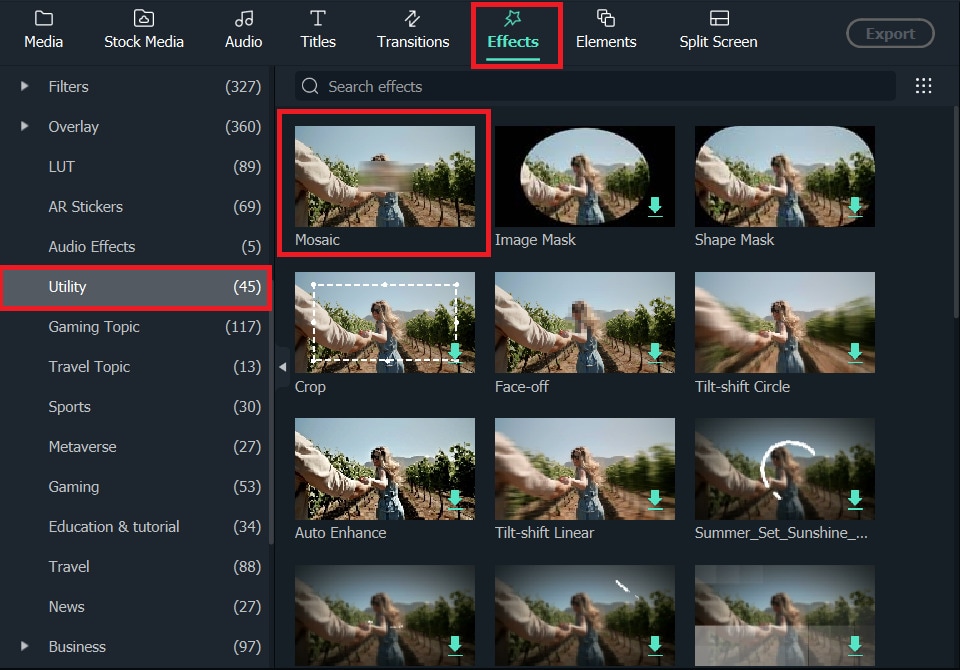
Check our picks of the best video editing software to blur faces in videos on Windows & Mac or learn more from Wondershare Video Community .
10 Best FREE iPhone and Android Apps for Blurring Faces in Photos and Videos
Concealing the identity of the people in your photos and videos is just the tip of the iceberg because the apps we featured in our top ten list allow you to manipulate images in any way you want. Let’s take a look at some of the best apps that can help you blur a face in just a few easy steps.
1. Skitch
Price: Free, offers in-app purchases
Compatibility: iOS
User Rating: 4.1
iPhone photographers in need of an app that enables them to snap and edit photos quickly will love using Skitch. The app is perfect for editing photos while you are on the go, as you can easily annotate images or add any text, stickers, or emojis to your photos. The Pixelate option lets you select the portion of the image you’d like to blur in just a couple of taps. Skitch’s photo editing capabilities can help you enhance the colors of each photo you take with this app. At the same time, its file-sharing features allow you to post your favorite creations on social media in seconds.
2. Video Mosaic
Price: Free, offers in-app purchases
Compatibility: iOS
User Rating: 4.6
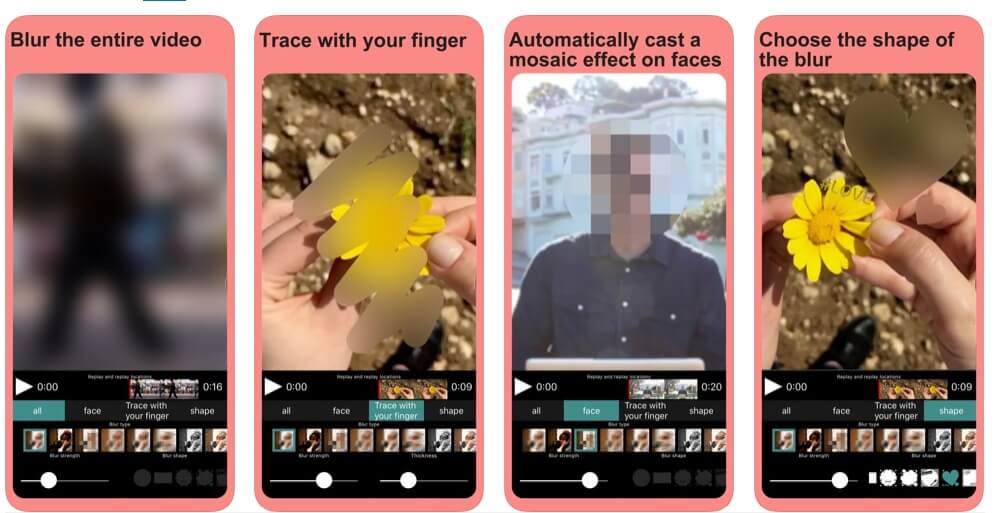
This app is designed with just one purpose, to enable iPhone users to blur videos while recording is in progress easily**.** You can choose from several different blur options, so you can blur an entire video, add an automatic mosaic over a face in the shot, or choose an area of the screen you’d like to blur. Moreover, the app lets you select the shape of the mosaic so the blurred area of the shot can have any form you want. The only downside is that you will have to make an in-app purchase to get rid of ads.
3. Video Toolbox Movie Maker
Price: Free, offers in-app purchases
Compatibility: iOS
User Rating: 3.5
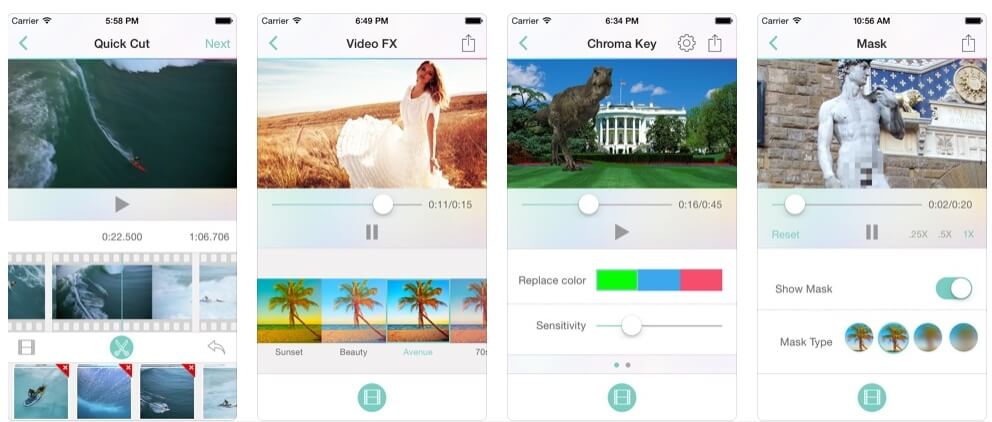
The video editing tools this iOS-based app offers will enable you to create professional-looking social media videos. There are over thirty transitions to choose from and more than twenty video effects. You can experiment with the Green Screen feature to combine two or more clips into a single video or try out the Reverse video option. Despite a solid number of video editing options, Video Toolbox offers only a limited number of face blurring options. The pixelate or blur effect you add to a video will be static, so if your subject moves a lot, you will have to use another app.
4. MovStash
Price: Free
Compatibility: iOS
User Rating: 3.7
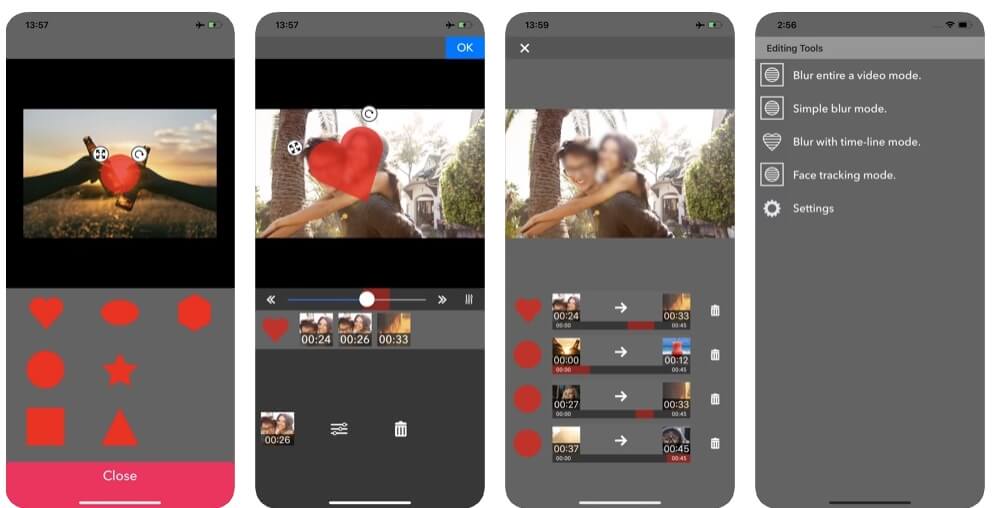
There are four types of blur you can choose from, and you can edit your videos in Simple and Timeline modes. You can specify the area of the shot you’d like to blur manually and use the slider to set the intensity of the blur effect. The Timeline mode lets you add as many blur areas to a video as you want so that you can blur multiple faces in a single shot. MovStash is specifically designed to make the process of blurring portions of a video quick and simple, but the app doesn’t offer any other video editing option.
5. KineMaster – Pro Video Editor
Price: Free, offers in-app purchases
User Rating: 4.7
KineMaster is a professional video editing app that enables users to trim a video frame by frame, apply the Chroma Key effect or add 3D transitions between video clips. That’s why it is not surprising that iPhone and Android users can easily blur faces in their videos with this app. However, the free version of KineMaster provides you with only a limited amount of options, and you have to make a series of in-app purchases to unlock all the features this app has to offer.
6. Blur Photos
Price: Free
Compatibility: iOS
User Rating: 4.3

Blur Photos app allows you to share your photos on all popular social networks in just a few taps. If you have an iOS 8 or a later version of this mobile operating system installed on your iPhone, you will be able to use this app as an extension for the Photos app. Blur Photos is completely free to use on iPhones, iPads, and iPod touch, so you can easily conceal the identity of people in your photos, regardless of the device you’re currently using. You can define the area of the picture you’d like to blur manually, and the app lets you control the intensity of the blur effect you’re applying.
7. Mosaic Pixelate Censor Photo
Price: Free
Compatibility: Android
User Rating: 4.2
![]()
You can blur the faces in your photos using the Mosaic, Pixelate, Blur, or Color options. You have to pick one of the options and designate the screen area you’d like to blur, and the app will do the rest for you. However, you can’t zoom into a photo, which means that you won’t have a great deal of control over the face blurring process in certain situations. The Mosaic Pixelate Censor Photo doesn’t offer any other photo editing options, which makes it a good choice only if you’re looking for an efficient tool that lets you censor photos quickly.
8. Point Blur
Price: Free, contains ads
Compatibility: Android
User Rating: 4.3

It is nothing complicated about blurring faces or any other photo part with this app. You have to use your finger to select the area of a picture you’d like to pixelate or blur and then proceed to choose the brush size and the intensity of the effect. In addition, you can use Point Blur to blur the background of a photo and create a smooth bokeh effect. Once you’ve blurred an image successfully, you can share it on any social media of your choice.
9.iMovie
Price: Free
Compatibility: iOS
User Rating: 3.9
Learn more details about How to blur faces in iMovie
Even though iMovie offers a rich selection of video editing options, unfortunately, there are no options that enable you to blur or pixelate a face. To conceal a beginning or an object in a video, you’ll have toadd a non-transparent layer over the area of the video you’d like to hide. This is by no means an elegant solution since adding a monochrome rectangle over a video can completely ruin its visual appeal. Using iMovie to conceal faces in videos is only a good option if, for whatever reason, you can’t install any other app that grants you more control over the process of blurring faces in videos.
10. Blur&Mosaic
Price: Free, offers in-app purchases
Compatibility: iOS
User Rating: 4.7

If you are looking for an app that makes obscuring faces in photos and videos easy, then Blur&Mosaic is probably one of the best choices you have at your disposal. You have to use your finger to mark the area you’d like to blur and choose from nine available mosaic styles. Furthermore, four different thickness and strength options allow you to control the amount of effect you’re going to apply to the image. However, the app contains ads, and you have to make an in-app purchase to remove them.
FAQs About Face Blur
1. How Do You Blur Out Faces in Photos on iPhone?
iPhone users can blur out faces with free blurring faces apps for photos and videos, such as Skitch, Video Mosaic, Video Toolbox Movie Maker, MovStash, KineMaster, and iMovie.
2. How Can I Blur Moving Face in a Video?
The Face-Off tool in Filmora can blur human faces or anything that looks like a face. You can also add emojis to the face of the subject. What’s more, the face-changer feature also comes with an in-built motion-tracker mechanism, which automatically sensors the position of a moving face and adjusts the emoji accordingly.
To blur faces , import your video, go to “Effects,” then search “Utility,” and select Face-Off. Choose an emoji if you want to add one; otherwise, click “OK.” The faces have now been blurred, and the video is ready to be exported.
A cross-platform for making videos anywhere for all creators

Why your video editing isn’t good enough? How about some creative inspo?
- 100 Million+ Users
- 150+ Countries and Regions
- 4 Million+ Social Media Followers
- 5 Million+ Stock Media for Use
* Secure Download

Conclusion
Just because a photo or a video contains information, you can’t share publicly shouldn’t be the reason why you can’t post it on your social media accounts. The apps we presented in this article are going to help you blur a face or conceal any other object in just a few easy steps. Which app do you like to use the most to blur faces in your videos and photos? Leave a comment below and share your experiences with us.

Ollie Mattison
Ollie Mattison is a writer and a lover of all things video.
Follow @Ollie Mattison
Ollie Mattison
Mar 27, 2024• Proven solutions
Respecting the privacy of the people who accidentally ended up in your shot is a common courtesy. In addition, making that material public can have legal consequences. So, to avoid needless complications, you can blur a person’s face before you share a photo or a video on social networks.
There are plenty of Android and iPhone apps that enable you to blur a face or any part of an image just moments after you’ve recorded a video or taken a photo. In this article, we will take you through the ten best free apps you can use to blur faces on your Android devices or iPhone & iPad.
Blurring Face/Object/Private Information With Wondershare Filmora
As a video editor with rich effects and tools, Filmora offers a few ways to blur a face or object, such as applying the Mosaic effect, Blurring effects, or Face-off. The video tutorial above is made with Filmora. Click Effects at the top, find Filter on the left, and click UTILITY; from there, you will see the mosaic, face-off, tilt-shift circle, and tilt-shift linear tools.

Check our picks of the best video editing software to blur faces in videos on Windows & Mac or learn more from Wondershare Video Community .
10 Best FREE iPhone and Android Apps for Blurring Faces in Photos and Videos
Concealing the identity of the people in your photos and videos is just the tip of the iceberg because the apps we featured in our top ten list allow you to manipulate images in any way you want. Let’s take a look at some of the best apps that can help you blur a face in just a few easy steps.
1. Skitch
Price: Free, offers in-app purchases
Compatibility: iOS
User Rating: 4.1
iPhone photographers in need of an app that enables them to snap and edit photos quickly will love using Skitch. The app is perfect for editing photos while you are on the go, as you can easily annotate images or add any text, stickers, or emojis to your photos. The Pixelate option lets you select the portion of the image you’d like to blur in just a couple of taps. Skitch’s photo editing capabilities can help you enhance the colors of each photo you take with this app. At the same time, its file-sharing features allow you to post your favorite creations on social media in seconds.
2. Video Mosaic
Price: Free, offers in-app purchases
Compatibility: iOS
User Rating: 4.6

This app is designed with just one purpose, to enable iPhone users to blur videos while recording is in progress easily**.** You can choose from several different blur options, so you can blur an entire video, add an automatic mosaic over a face in the shot, or choose an area of the screen you’d like to blur. Moreover, the app lets you select the shape of the mosaic so the blurred area of the shot can have any form you want. The only downside is that you will have to make an in-app purchase to get rid of ads.
3. Video Toolbox Movie Maker
Price: Free, offers in-app purchases
Compatibility: iOS
User Rating: 3.5

The video editing tools this iOS-based app offers will enable you to create professional-looking social media videos. There are over thirty transitions to choose from and more than twenty video effects. You can experiment with the Green Screen feature to combine two or more clips into a single video or try out the Reverse video option. Despite a solid number of video editing options, Video Toolbox offers only a limited number of face blurring options. The pixelate or blur effect you add to a video will be static, so if your subject moves a lot, you will have to use another app.
4. MovStash
Price: Free
Compatibility: iOS
User Rating: 3.7

There are four types of blur you can choose from, and you can edit your videos in Simple and Timeline modes. You can specify the area of the shot you’d like to blur manually and use the slider to set the intensity of the blur effect. The Timeline mode lets you add as many blur areas to a video as you want so that you can blur multiple faces in a single shot. MovStash is specifically designed to make the process of blurring portions of a video quick and simple, but the app doesn’t offer any other video editing option.
5. KineMaster – Pro Video Editor
Price: Free, offers in-app purchases
User Rating: 4.7
KineMaster is a professional video editing app that enables users to trim a video frame by frame, apply the Chroma Key effect or add 3D transitions between video clips. That’s why it is not surprising that iPhone and Android users can easily blur faces in their videos with this app. However, the free version of KineMaster provides you with only a limited amount of options, and you have to make a series of in-app purchases to unlock all the features this app has to offer.
6. Blur Photos
Price: Free
Compatibility: iOS
User Rating: 4.3

Blur Photos app allows you to share your photos on all popular social networks in just a few taps. If you have an iOS 8 or a later version of this mobile operating system installed on your iPhone, you will be able to use this app as an extension for the Photos app. Blur Photos is completely free to use on iPhones, iPads, and iPod touch, so you can easily conceal the identity of people in your photos, regardless of the device you’re currently using. You can define the area of the picture you’d like to blur manually, and the app lets you control the intensity of the blur effect you’re applying.
7. Mosaic Pixelate Censor Photo
Price: Free
Compatibility: Android
User Rating: 4.2
![]()
You can blur the faces in your photos using the Mosaic, Pixelate, Blur, or Color options. You have to pick one of the options and designate the screen area you’d like to blur, and the app will do the rest for you. However, you can’t zoom into a photo, which means that you won’t have a great deal of control over the face blurring process in certain situations. The Mosaic Pixelate Censor Photo doesn’t offer any other photo editing options, which makes it a good choice only if you’re looking for an efficient tool that lets you censor photos quickly.
8. Point Blur
Price: Free, contains ads
Compatibility: Android
User Rating: 4.3

It is nothing complicated about blurring faces or any other photo part with this app. You have to use your finger to select the area of a picture you’d like to pixelate or blur and then proceed to choose the brush size and the intensity of the effect. In addition, you can use Point Blur to blur the background of a photo and create a smooth bokeh effect. Once you’ve blurred an image successfully, you can share it on any social media of your choice.
9.iMovie
Price: Free
Compatibility: iOS
User Rating: 3.9
Learn more details about How to blur faces in iMovie
Even though iMovie offers a rich selection of video editing options, unfortunately, there are no options that enable you to blur or pixelate a face. To conceal a beginning or an object in a video, you’ll have toadd a non-transparent layer over the area of the video you’d like to hide. This is by no means an elegant solution since adding a monochrome rectangle over a video can completely ruin its visual appeal. Using iMovie to conceal faces in videos is only a good option if, for whatever reason, you can’t install any other app that grants you more control over the process of blurring faces in videos.
10. Blur&Mosaic
Price: Free, offers in-app purchases
Compatibility: iOS
User Rating: 4.7

If you are looking for an app that makes obscuring faces in photos and videos easy, then Blur&Mosaic is probably one of the best choices you have at your disposal. You have to use your finger to mark the area you’d like to blur and choose from nine available mosaic styles. Furthermore, four different thickness and strength options allow you to control the amount of effect you’re going to apply to the image. However, the app contains ads, and you have to make an in-app purchase to remove them.
FAQs About Face Blur
1. How Do You Blur Out Faces in Photos on iPhone?
iPhone users can blur out faces with free blurring faces apps for photos and videos, such as Skitch, Video Mosaic, Video Toolbox Movie Maker, MovStash, KineMaster, and iMovie.
2. How Can I Blur Moving Face in a Video?
The Face-Off tool in Filmora can blur human faces or anything that looks like a face. You can also add emojis to the face of the subject. What’s more, the face-changer feature also comes with an in-built motion-tracker mechanism, which automatically sensors the position of a moving face and adjusts the emoji accordingly.
To blur faces , import your video, go to “Effects,” then search “Utility,” and select Face-Off. Choose an emoji if you want to add one; otherwise, click “OK.” The faces have now been blurred, and the video is ready to be exported.
A cross-platform for making videos anywhere for all creators

Why your video editing isn’t good enough? How about some creative inspo?
- 100 Million+ Users
- 150+ Countries and Regions
- 4 Million+ Social Media Followers
- 5 Million+ Stock Media for Use
* Secure Download

Conclusion
Just because a photo or a video contains information, you can’t share publicly shouldn’t be the reason why you can’t post it on your social media accounts. The apps we presented in this article are going to help you blur a face or conceal any other object in just a few easy steps. Which app do you like to use the most to blur faces in your videos and photos? Leave a comment below and share your experiences with us.

Ollie Mattison
Ollie Mattison is a writer and a lover of all things video.
Follow @Ollie Mattison
Ollie Mattison
Mar 27, 2024• Proven solutions
Respecting the privacy of the people who accidentally ended up in your shot is a common courtesy. In addition, making that material public can have legal consequences. So, to avoid needless complications, you can blur a person’s face before you share a photo or a video on social networks.
There are plenty of Android and iPhone apps that enable you to blur a face or any part of an image just moments after you’ve recorded a video or taken a photo. In this article, we will take you through the ten best free apps you can use to blur faces on your Android devices or iPhone & iPad.
Blurring Face/Object/Private Information With Wondershare Filmora
As a video editor with rich effects and tools, Filmora offers a few ways to blur a face or object, such as applying the Mosaic effect, Blurring effects, or Face-off. The video tutorial above is made with Filmora. Click Effects at the top, find Filter on the left, and click UTILITY; from there, you will see the mosaic, face-off, tilt-shift circle, and tilt-shift linear tools.

Check our picks of the best video editing software to blur faces in videos on Windows & Mac or learn more from Wondershare Video Community .
10 Best FREE iPhone and Android Apps for Blurring Faces in Photos and Videos
Concealing the identity of the people in your photos and videos is just the tip of the iceberg because the apps we featured in our top ten list allow you to manipulate images in any way you want. Let’s take a look at some of the best apps that can help you blur a face in just a few easy steps.
1. Skitch
Price: Free, offers in-app purchases
Compatibility: iOS
User Rating: 4.1
iPhone photographers in need of an app that enables them to snap and edit photos quickly will love using Skitch. The app is perfect for editing photos while you are on the go, as you can easily annotate images or add any text, stickers, or emojis to your photos. The Pixelate option lets you select the portion of the image you’d like to blur in just a couple of taps. Skitch’s photo editing capabilities can help you enhance the colors of each photo you take with this app. At the same time, its file-sharing features allow you to post your favorite creations on social media in seconds.
2. Video Mosaic
Price: Free, offers in-app purchases
Compatibility: iOS
User Rating: 4.6

This app is designed with just one purpose, to enable iPhone users to blur videos while recording is in progress easily**.** You can choose from several different blur options, so you can blur an entire video, add an automatic mosaic over a face in the shot, or choose an area of the screen you’d like to blur. Moreover, the app lets you select the shape of the mosaic so the blurred area of the shot can have any form you want. The only downside is that you will have to make an in-app purchase to get rid of ads.
3. Video Toolbox Movie Maker
Price: Free, offers in-app purchases
Compatibility: iOS
User Rating: 3.5

The video editing tools this iOS-based app offers will enable you to create professional-looking social media videos. There are over thirty transitions to choose from and more than twenty video effects. You can experiment with the Green Screen feature to combine two or more clips into a single video or try out the Reverse video option. Despite a solid number of video editing options, Video Toolbox offers only a limited number of face blurring options. The pixelate or blur effect you add to a video will be static, so if your subject moves a lot, you will have to use another app.
4. MovStash
Price: Free
Compatibility: iOS
User Rating: 3.7

There are four types of blur you can choose from, and you can edit your videos in Simple and Timeline modes. You can specify the area of the shot you’d like to blur manually and use the slider to set the intensity of the blur effect. The Timeline mode lets you add as many blur areas to a video as you want so that you can blur multiple faces in a single shot. MovStash is specifically designed to make the process of blurring portions of a video quick and simple, but the app doesn’t offer any other video editing option.
5. KineMaster – Pro Video Editor
Price: Free, offers in-app purchases
User Rating: 4.7
KineMaster is a professional video editing app that enables users to trim a video frame by frame, apply the Chroma Key effect or add 3D transitions between video clips. That’s why it is not surprising that iPhone and Android users can easily blur faces in their videos with this app. However, the free version of KineMaster provides you with only a limited amount of options, and you have to make a series of in-app purchases to unlock all the features this app has to offer.
6. Blur Photos
Price: Free
Compatibility: iOS
User Rating: 4.3

Blur Photos app allows you to share your photos on all popular social networks in just a few taps. If you have an iOS 8 or a later version of this mobile operating system installed on your iPhone, you will be able to use this app as an extension for the Photos app. Blur Photos is completely free to use on iPhones, iPads, and iPod touch, so you can easily conceal the identity of people in your photos, regardless of the device you’re currently using. You can define the area of the picture you’d like to blur manually, and the app lets you control the intensity of the blur effect you’re applying.
7. Mosaic Pixelate Censor Photo
Price: Free
Compatibility: Android
User Rating: 4.2
![]()
You can blur the faces in your photos using the Mosaic, Pixelate, Blur, or Color options. You have to pick one of the options and designate the screen area you’d like to blur, and the app will do the rest for you. However, you can’t zoom into a photo, which means that you won’t have a great deal of control over the face blurring process in certain situations. The Mosaic Pixelate Censor Photo doesn’t offer any other photo editing options, which makes it a good choice only if you’re looking for an efficient tool that lets you censor photos quickly.
8. Point Blur
Price: Free, contains ads
Compatibility: Android
User Rating: 4.3

It is nothing complicated about blurring faces or any other photo part with this app. You have to use your finger to select the area of a picture you’d like to pixelate or blur and then proceed to choose the brush size and the intensity of the effect. In addition, you can use Point Blur to blur the background of a photo and create a smooth bokeh effect. Once you’ve blurred an image successfully, you can share it on any social media of your choice.
9.iMovie
Price: Free
Compatibility: iOS
User Rating: 3.9
Learn more details about How to blur faces in iMovie
Even though iMovie offers a rich selection of video editing options, unfortunately, there are no options that enable you to blur or pixelate a face. To conceal a beginning or an object in a video, you’ll have toadd a non-transparent layer over the area of the video you’d like to hide. This is by no means an elegant solution since adding a monochrome rectangle over a video can completely ruin its visual appeal. Using iMovie to conceal faces in videos is only a good option if, for whatever reason, you can’t install any other app that grants you more control over the process of blurring faces in videos.
10. Blur&Mosaic
Price: Free, offers in-app purchases
Compatibility: iOS
User Rating: 4.7

If you are looking for an app that makes obscuring faces in photos and videos easy, then Blur&Mosaic is probably one of the best choices you have at your disposal. You have to use your finger to mark the area you’d like to blur and choose from nine available mosaic styles. Furthermore, four different thickness and strength options allow you to control the amount of effect you’re going to apply to the image. However, the app contains ads, and you have to make an in-app purchase to remove them.
FAQs About Face Blur
1. How Do You Blur Out Faces in Photos on iPhone?
iPhone users can blur out faces with free blurring faces apps for photos and videos, such as Skitch, Video Mosaic, Video Toolbox Movie Maker, MovStash, KineMaster, and iMovie.
2. How Can I Blur Moving Face in a Video?
The Face-Off tool in Filmora can blur human faces or anything that looks like a face. You can also add emojis to the face of the subject. What’s more, the face-changer feature also comes with an in-built motion-tracker mechanism, which automatically sensors the position of a moving face and adjusts the emoji accordingly.
To blur faces , import your video, go to “Effects,” then search “Utility,” and select Face-Off. Choose an emoji if you want to add one; otherwise, click “OK.” The faces have now been blurred, and the video is ready to be exported.
A cross-platform for making videos anywhere for all creators

Why your video editing isn’t good enough? How about some creative inspo?
- 100 Million+ Users
- 150+ Countries and Regions
- 4 Million+ Social Media Followers
- 5 Million+ Stock Media for Use
* Secure Download

Conclusion
Just because a photo or a video contains information, you can’t share publicly shouldn’t be the reason why you can’t post it on your social media accounts. The apps we presented in this article are going to help you blur a face or conceal any other object in just a few easy steps. Which app do you like to use the most to blur faces in your videos and photos? Leave a comment below and share your experiences with us.

Ollie Mattison
Ollie Mattison is a writer and a lover of all things video.
Follow @Ollie Mattison
Ollie Mattison
Mar 27, 2024• Proven solutions
Respecting the privacy of the people who accidentally ended up in your shot is a common courtesy. In addition, making that material public can have legal consequences. So, to avoid needless complications, you can blur a person’s face before you share a photo or a video on social networks.
There are plenty of Android and iPhone apps that enable you to blur a face or any part of an image just moments after you’ve recorded a video or taken a photo. In this article, we will take you through the ten best free apps you can use to blur faces on your Android devices or iPhone & iPad.
Blurring Face/Object/Private Information With Wondershare Filmora
As a video editor with rich effects and tools, Filmora offers a few ways to blur a face or object, such as applying the Mosaic effect, Blurring effects, or Face-off. The video tutorial above is made with Filmora. Click Effects at the top, find Filter on the left, and click UTILITY; from there, you will see the mosaic, face-off, tilt-shift circle, and tilt-shift linear tools.

Check our picks of the best video editing software to blur faces in videos on Windows & Mac or learn more from Wondershare Video Community .
10 Best FREE iPhone and Android Apps for Blurring Faces in Photos and Videos
Concealing the identity of the people in your photos and videos is just the tip of the iceberg because the apps we featured in our top ten list allow you to manipulate images in any way you want. Let’s take a look at some of the best apps that can help you blur a face in just a few easy steps.
1. Skitch
Price: Free, offers in-app purchases
Compatibility: iOS
User Rating: 4.1
iPhone photographers in need of an app that enables them to snap and edit photos quickly will love using Skitch. The app is perfect for editing photos while you are on the go, as you can easily annotate images or add any text, stickers, or emojis to your photos. The Pixelate option lets you select the portion of the image you’d like to blur in just a couple of taps. Skitch’s photo editing capabilities can help you enhance the colors of each photo you take with this app. At the same time, its file-sharing features allow you to post your favorite creations on social media in seconds.
2. Video Mosaic
Price: Free, offers in-app purchases
Compatibility: iOS
User Rating: 4.6

This app is designed with just one purpose, to enable iPhone users to blur videos while recording is in progress easily**.** You can choose from several different blur options, so you can blur an entire video, add an automatic mosaic over a face in the shot, or choose an area of the screen you’d like to blur. Moreover, the app lets you select the shape of the mosaic so the blurred area of the shot can have any form you want. The only downside is that you will have to make an in-app purchase to get rid of ads.
3. Video Toolbox Movie Maker
Price: Free, offers in-app purchases
Compatibility: iOS
User Rating: 3.5

The video editing tools this iOS-based app offers will enable you to create professional-looking social media videos. There are over thirty transitions to choose from and more than twenty video effects. You can experiment with the Green Screen feature to combine two or more clips into a single video or try out the Reverse video option. Despite a solid number of video editing options, Video Toolbox offers only a limited number of face blurring options. The pixelate or blur effect you add to a video will be static, so if your subject moves a lot, you will have to use another app.
4. MovStash
Price: Free
Compatibility: iOS
User Rating: 3.7

There are four types of blur you can choose from, and you can edit your videos in Simple and Timeline modes. You can specify the area of the shot you’d like to blur manually and use the slider to set the intensity of the blur effect. The Timeline mode lets you add as many blur areas to a video as you want so that you can blur multiple faces in a single shot. MovStash is specifically designed to make the process of blurring portions of a video quick and simple, but the app doesn’t offer any other video editing option.
5. KineMaster – Pro Video Editor
Price: Free, offers in-app purchases
User Rating: 4.7
KineMaster is a professional video editing app that enables users to trim a video frame by frame, apply the Chroma Key effect or add 3D transitions between video clips. That’s why it is not surprising that iPhone and Android users can easily blur faces in their videos with this app. However, the free version of KineMaster provides you with only a limited amount of options, and you have to make a series of in-app purchases to unlock all the features this app has to offer.
6. Blur Photos
Price: Free
Compatibility: iOS
User Rating: 4.3

Blur Photos app allows you to share your photos on all popular social networks in just a few taps. If you have an iOS 8 or a later version of this mobile operating system installed on your iPhone, you will be able to use this app as an extension for the Photos app. Blur Photos is completely free to use on iPhones, iPads, and iPod touch, so you can easily conceal the identity of people in your photos, regardless of the device you’re currently using. You can define the area of the picture you’d like to blur manually, and the app lets you control the intensity of the blur effect you’re applying.
7. Mosaic Pixelate Censor Photo
Price: Free
Compatibility: Android
User Rating: 4.2
![]()
You can blur the faces in your photos using the Mosaic, Pixelate, Blur, or Color options. You have to pick one of the options and designate the screen area you’d like to blur, and the app will do the rest for you. However, you can’t zoom into a photo, which means that you won’t have a great deal of control over the face blurring process in certain situations. The Mosaic Pixelate Censor Photo doesn’t offer any other photo editing options, which makes it a good choice only if you’re looking for an efficient tool that lets you censor photos quickly.
8. Point Blur
Price: Free, contains ads
Compatibility: Android
User Rating: 4.3

It is nothing complicated about blurring faces or any other photo part with this app. You have to use your finger to select the area of a picture you’d like to pixelate or blur and then proceed to choose the brush size and the intensity of the effect. In addition, you can use Point Blur to blur the background of a photo and create a smooth bokeh effect. Once you’ve blurred an image successfully, you can share it on any social media of your choice.
9.iMovie
Price: Free
Compatibility: iOS
User Rating: 3.9
Learn more details about How to blur faces in iMovie
Even though iMovie offers a rich selection of video editing options, unfortunately, there are no options that enable you to blur or pixelate a face. To conceal a beginning or an object in a video, you’ll have toadd a non-transparent layer over the area of the video you’d like to hide. This is by no means an elegant solution since adding a monochrome rectangle over a video can completely ruin its visual appeal. Using iMovie to conceal faces in videos is only a good option if, for whatever reason, you can’t install any other app that grants you more control over the process of blurring faces in videos.
10. Blur&Mosaic
Price: Free, offers in-app purchases
Compatibility: iOS
User Rating: 4.7

If you are looking for an app that makes obscuring faces in photos and videos easy, then Blur&Mosaic is probably one of the best choices you have at your disposal. You have to use your finger to mark the area you’d like to blur and choose from nine available mosaic styles. Furthermore, four different thickness and strength options allow you to control the amount of effect you’re going to apply to the image. However, the app contains ads, and you have to make an in-app purchase to remove them.
FAQs About Face Blur
1. How Do You Blur Out Faces in Photos on iPhone?
iPhone users can blur out faces with free blurring faces apps for photos and videos, such as Skitch, Video Mosaic, Video Toolbox Movie Maker, MovStash, KineMaster, and iMovie.
2. How Can I Blur Moving Face in a Video?
The Face-Off tool in Filmora can blur human faces or anything that looks like a face. You can also add emojis to the face of the subject. What’s more, the face-changer feature also comes with an in-built motion-tracker mechanism, which automatically sensors the position of a moving face and adjusts the emoji accordingly.
To blur faces , import your video, go to “Effects,” then search “Utility,” and select Face-Off. Choose an emoji if you want to add one; otherwise, click “OK.” The faces have now been blurred, and the video is ready to be exported.
A cross-platform for making videos anywhere for all creators

Why your video editing isn’t good enough? How about some creative inspo?
- 100 Million+ Users
- 150+ Countries and Regions
- 4 Million+ Social Media Followers
- 5 Million+ Stock Media for Use
* Secure Download

Conclusion
Just because a photo or a video contains information, you can’t share publicly shouldn’t be the reason why you can’t post it on your social media accounts. The apps we presented in this article are going to help you blur a face or conceal any other object in just a few easy steps. Which app do you like to use the most to blur faces in your videos and photos? Leave a comment below and share your experiences with us.

Ollie Mattison
Ollie Mattison is a writer and a lover of all things video.
Follow @Ollie Mattison
Also read:
- 2024 Approved The Lowdown on Minitool Movie Maker Review, Tips, and Alternative Video Editors
- In 2024, Virtualdub Limitations Why You Need to Consider These Alternatives
- Updated 2024 Approved Edit Your Way to Viral Top 10 Vlog Editing Apps for Mobile
- Updated Maximize Your Music Library Tips and Reviews for YouTube to MP3 Conversion
- Updated In 2024, Best Video Cutting Software for Windows and Web
- New YouTube Audio Downloader Tips, Tricks, and Best Practices for 2024
- New Best Highlight Video Makers Desktop & Mobile Choices for 2024
- New Revolutionize Your Sound 10 Best Online Waveform Generators for 2024
- Updated 2024 Approved Download KineMaster for macOS A Beginners Guide
- Updated In 2024, Loop Your Videos for Free Top Picks
- Updated Free Android Video Editing Apps No Watermark, No Catch for 2024
- Updated In 2024, Silence Is Golden A Step-by-Step Guide to Noise Reduction in FCPX
- Updated The Best Watermark-Free Video Joining Software for You
- Updated 8 Essential Video Editing Tools That Wont Slow You Down for 2024
- Updated In 2024, Facebook Video to MP3 Top Online Conversion Tools
- Updated 2024 Approved Sound Design on a Budget How to Find and Integrate Free Sound Effects in Final Cut Pro
- New 2024 Approved Skin Perfection without the Price Tag FCPX Plugin-Free Tutorial
- Updated In 2024, Expert Gaming Intro Developers You Can Trust
- Updated 2024 Approved Convert MP4 to MP3 on the Go Best Apps for iPhone and Android
- Updated 2024 Approved From Widescreen to Vertical The Simplest Way to Resize Social Media Videos
- Updated 2024 Approved VN Video Editor App Review Pros and Cons
- New In 2024, Clean Up Your Audio Advanced Techniques for Removing Background Noise in FCPX
- New Bring Back the 80S Best VHS Effect Apps for iPhone and Android Devices for 2024
- New Video to Audio Conversion Made Easy My 5 Essential Selection Tips
- In 2024, The Ultimate Checklist for Picking a Trustworthy YouTube to MP3 Converter
- 2024 Approved Zero-Cost Video Editing The Best Online Options
- Updated 2024 Approved Top 10 Free Video Invitation Creators
- New 2024 Approved Best of the Bunch Free Video Editors for Ubuntu Users
- New Unleash the Power of Reversal Advanced TikTok Video Editing Techniques for 2024
- New 2024 Approved Lossless Audio at Your Fingertips Top-Rated FLAC Conversion Solutions
- New 2024 Approved Free Video Editing Software 10 Options Beyond Movie Maker
- Revolutionize Your Animation Workflow 7 Must-Try Drawing Software for 2024
- New 2024 Approved Transform Your Videos with AVS Mac Editor
- Updated The Best of Both Worlds Free and Paid 3D Animation Software for Artists
- New In 2024, The Art of Aspect Ratio How It Shapes Your YouTube Videos Narrative and Style
- New In 2024, Video Editing on Chromebook A Step-by-Step Guide to Using Any App
- New 2024 Approved Convert Instagram Videos to MP3 Easy Download Methods
- Updated Final Cut Pros Masterpieces 10 Must-Watch Movies for 2024
- S Best Android Video Editors Free, Paid, and Everything in Between for 2024
- New Top-Rated Free WMV Video Editing Software with Splitting Features
- New The Ultimate Guide to Free iPhone Video Rotation Tools
- How to get the dragon scale and evolution-enabled pokemon On Apple iPhone 15? | Dr.fone
- Hassle-Free Ways to Remove FRP Lock on Lenovo ThinkPhone Phones with/without a PC
- Full Guide to Fix iToolab AnyGO Not Working On Apple iPhone 11 Pro | Dr.fone
- Will iSpoofer update On Xiaomi Redmi K70 | Dr.fone
- In 2024, Best Anti Tracker Software For Vivo V27e | Dr.fone
- In 2024, How to Fake Snapchat Location on Lava Blaze 2 Pro | Dr.fone
- How to Update iPhone 14 Pro Max without Losing Any Data? | Dr.fone
- How to Fake GPS on Android without Mock Location For your Honor Magic 5 | Dr.fone
- In 2024, Top 9 Oppo A58 4G Monitoring Apps for Parental Controls | Dr.fone
- How to Check Distance and Radius on Google Maps For your Realme C55 | Dr.fone
- Updated How to Make an Aesthetic Slideshow
- Unlock Poco C51 Phone Password Without Factory Reset Full Guide Here
- 3uTools Virtual Location Not Working On Motorola Edge 40 Neo? Fix Now | Dr.fone
- Pokémon Go Cooldown Chart On Honor Play 40C | Dr.fone
- Process of Screen Sharing Honor X50i to PC- Detailed Steps | Dr.fone
- Ultimate Guide from Xiaomi Redmi 12 FRP Bypass
- Best Android Data Recovery - undelete lost call logs from Nokia G310
- In 2024, Two Ways to Track My Boyfriends OnePlus Nord CE 3 Lite 5G without Him Knowing | Dr.fone
- 9 Quick Fixes to Unfortunately TouchWiz has stopped Of Vivo Y55s 5G (2023) | Dr.fone
- 2024 Approved Mastering Image Proportions A Beginners Guide to Ratio Calculators
- How To Transfer WhatsApp From Apple iPhone 7 to other iPhone 13 devices? | Dr.fone
- Identify missing or malfunctioning drivers with Windows Device Manager on Windows 11/10
- Prevent Cross-Site Tracking on Apple iPhone SE and Browser | Dr.fone
- The Ultimate Guide to Get the Rare Candy on Pokemon Go Fire Red On Motorola Edge+ (2023) | Dr.fone
- 11 Best Location Changers for Samsung Galaxy S24 | Dr.fone
- Life360 Learn How Everything Works On Vivo Y27 4G | Dr.fone
- In 2024, How To Remove Passcode From Apple iPhone XR? Complete Guide | Dr.fone
- Complete Tutorial Sending Photos From Apple iPhone 11 Pro to iPad | Dr.fone
- Easy Guide to Xiaomi Redmi K70 Pro FRP Bypass With Best Methods
- New 2024 Approved Capture Your Best Top 10 Webcam Recording Software for Windows 10
- The Ultimate Guide to Get the Rare Candy on Pokemon Go Fire Red On Vivo S18e | Dr.fone
- A Working Guide For Pachirisu Pokemon Go Map On Apple iPhone 7 Plus | Dr.fone
- In 2024, How to Hide/Fake Snapchat Location on Your Oppo Find X7 | Dr.fone
- In 2024, How to Unlock SIM Card on iPhone 13 online without jailbreak
- 3 Methods to Mirror Gionee F3 Pro to Roku | Dr.fone
- In 2024, Catch or Beat Sleeping Snorlax on Pokemon Go For Apple iPhone 12 Pro Max | Dr.fone
- 10 Fake GPS Location Apps on Android Of your Oppo A78 5G | Dr.fone
- In 2024, 3 Things You Must Know about Fake Snapchat Location On Vivo Y27 5G | Dr.fone
- Title: Updated 2024 Approved Chromebook Linux Installation A Simple, Step-by-Step Process (Updated )
- Author: Isabella
- Created at : 2024-05-19 13:04:14
- Updated at : 2024-05-20 13:04:14
- Link: https://video-creation-software.techidaily.com/updated-2024-approved-chromebook-linux-installation-a-simple-step-by-step-process-updated/
- License: This work is licensed under CC BY-NC-SA 4.0.








